Forums
- Forums
- Axis And Allies Forum
- General Discussion
- Aviation News
Aviation News
Post a reply
- Go to Previous topic
- Go to Next topic
- Go to Welcome
- Go to Introduce Yourself
- Go to General Discussion
- Go to Screenshots, Images and Videos
- Go to Off topic
- Go to Works in Progress
- Go to Skinning Tips / Tutorials
- Go to Skin Requests
- Go to IJAAF Library
- Go to Luftwaffe Library
- Go to RAF Library
- Go to USAAF / USN Library
- Go to Misc Library
- Go to The Ops Room
- Go to Made in Germany
- Go to Campaigns and Missions
- Go to Works in Progress
- Go to Juri's Air-Raid Shelter
- Go to Campaigns and Missions
- Go to Works in Progress
- Go to Skinpacks
- Go to External Projects Discussion
- Go to Books & Resources
-
 Main AdminU.S. F-15C Eagles from the 493rd Expeditionary Fighter Squadron peel away from a formation with Royal Danish F-16's to signify the transfer of the NATO Baltic Air Police mission at Siauliai Air Base, Lithuania Jan. 8. NATO Air Policing is a peacetime collective defense mission, safeguarding the integrity of the NATO Alliance member?s airspace. (U.S. Air Force photo/ Tech. Sgt. Matthew Plew)
Main AdminU.S. F-15C Eagles from the 493rd Expeditionary Fighter Squadron peel away from a formation with Royal Danish F-16's to signify the transfer of the NATO Baltic Air Police mission at Siauliai Air Base, Lithuania Jan. 8. NATO Air Policing is a peacetime collective defense mission, safeguarding the integrity of the NATO Alliance member?s airspace. (U.S. Air Force photo/ Tech. Sgt. Matthew Plew)
A Royal Danish F-16 pilot taxis to park after completion of a Baltic Air Policing sortie at ?iauliai Air Base, Lithuania, Jan. 8, 2018. NATO Air Policing is a peacetime collective defense mission, safeguarding the integrity of the NATO Alliance member?s airspace. (U.S. Air Force photo/ Tech. Sgt. Matthew Plew)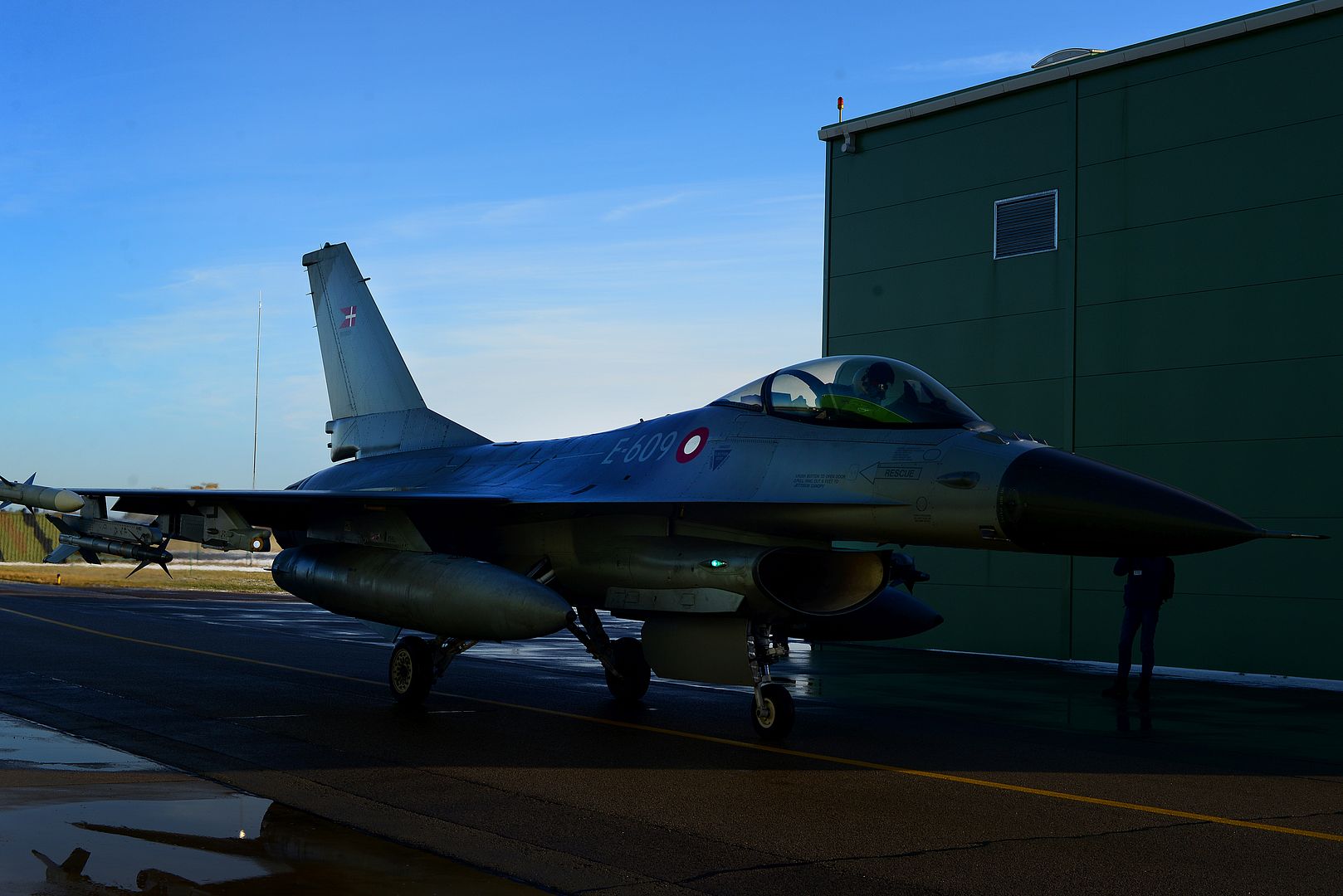
SEATTLE, Jan. 8, 2018 /PRNewswire/ -- Boeing [NYSE:BA] and Turkish Airlines announced that the carrier ordered three more 777 Freighters in December 2017. The new order came weeks after the carrier took delivery of two of the large cargo jets as part of its plan to further expand its freight business.
"These freighter orders will surely contribute to our significant target for establishing a young and efficient cargo fleet," said M. ?lker Ayc?, Chairman of the Board and the Executive Committee of Turkish Airlines. "The new aircraft will be delivered this year and will provide us with additional flexibility to serve more destinations while we continue to develop our global freight service."
"The 777 Freighter is the largest and most capable twin-engine freighter in the world today," said Marty Bentrott, senior vice president of Sales, Middle East, Turkey, Russia, Central Asia and Africa, Boeing Commercial Airplanes. "We're pleased world-class customers like Turkish Airlines recognize the value of the 777 Freighter's long range and large payload capability."
The 777 Freighter is the world's longest-range twin-engine freighter and is based on the 777-200LR (Longer Range) passenger airplane. The jet can fly 4,900 nautical miles (9,070 kilometers) with a full payload of 112 tons (102 metric tonnes or 102,000 kg).
The airplane's range capability translates into significant savings for airlines: fewer stops and associated landing fees, less congestion at transfer hubs, lower cargo handling costs and shorter cargo delivery times.
About Turkish Airlines
Based in Istanbul, Turkish Airlines is one of the fastest growing airlines in the world. It carries over 60 million passengers a year, with direct flights to 300 destinations in 120 countries. The airline made its first domestic flight in 1933 and the first international flight in 1947. Turkish Airlines was founded in 1933 with a fleet of five airplanes that carried a total of 28 passengers, expanding to 331 aircraft today.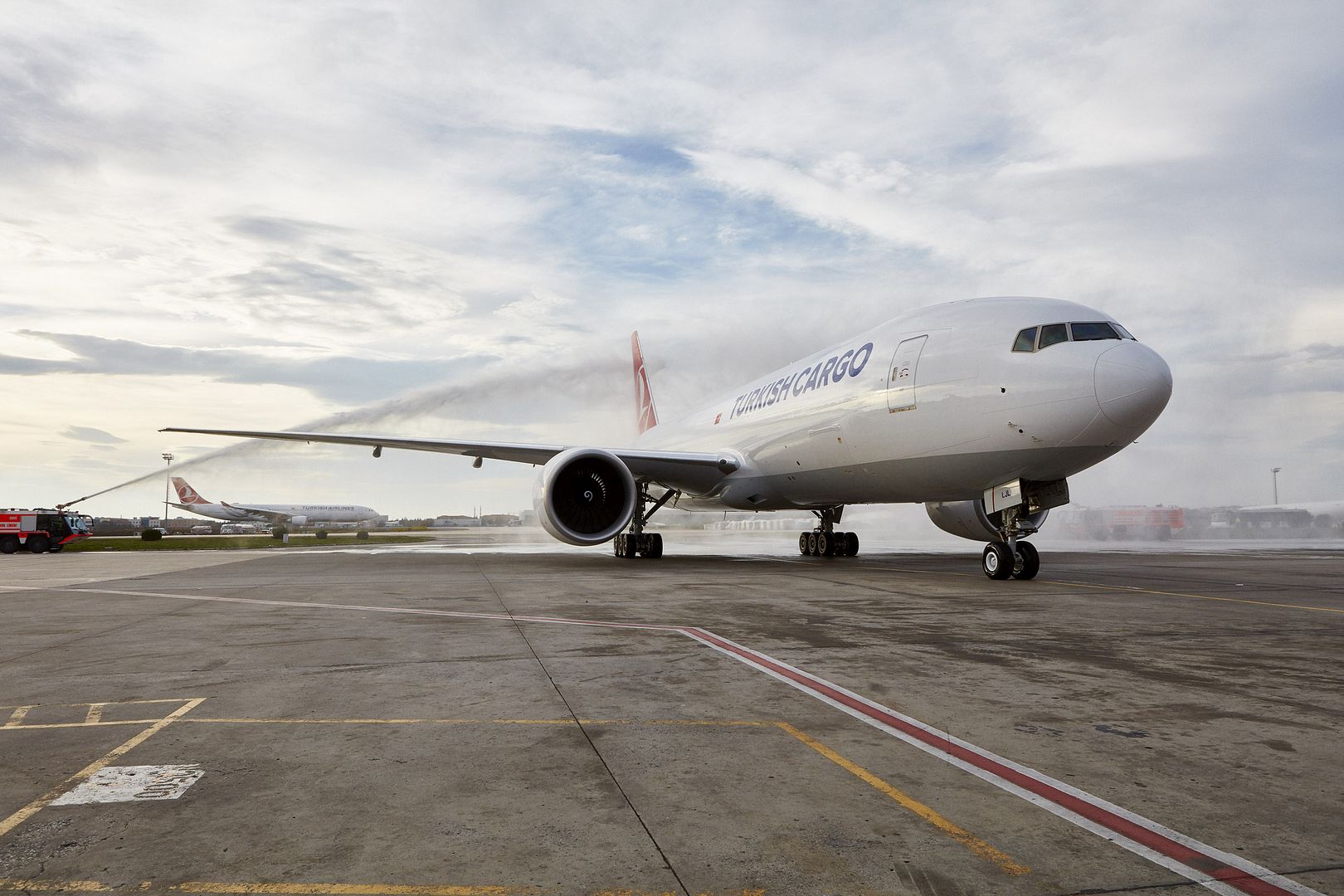
The first structurally complete airframe for the new BelugaXL rolled out from its assembly hangar in Toulouse, France this month. Once operational, a fleet of these next-generation airlifters will be used to transport completed sections of Airbus aircraft among the company?s European production sites and to its final assembly lines in France, Germany and Spain.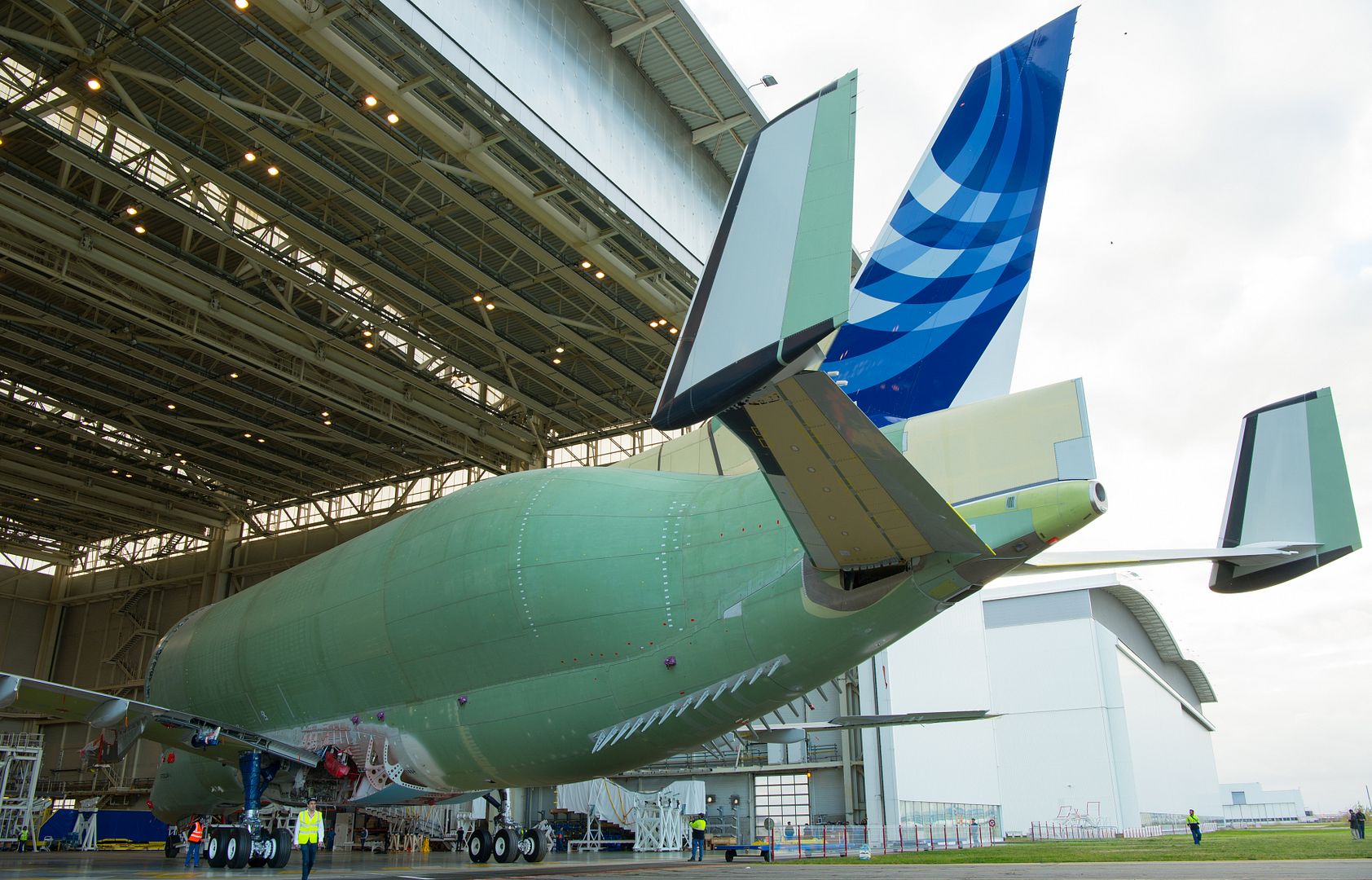
The BelugaXL is one of the most voluminous aircraft in existence, and everything about it speaks to that fact. With a bulging upper forward fuselage and enormous cargo area, the BelugaXL is hardly recognizable as the outsized airlifter version of the Airbus A330-200 jetliner from which it is derived. ?We have the A330 as a foundation,? said Bertrand George, head of the BelugaXL programme, ?but many changes have been successfully designed, introduced into the aircraft and tested. Transforming an existing product into a super transporter is not a simple task.?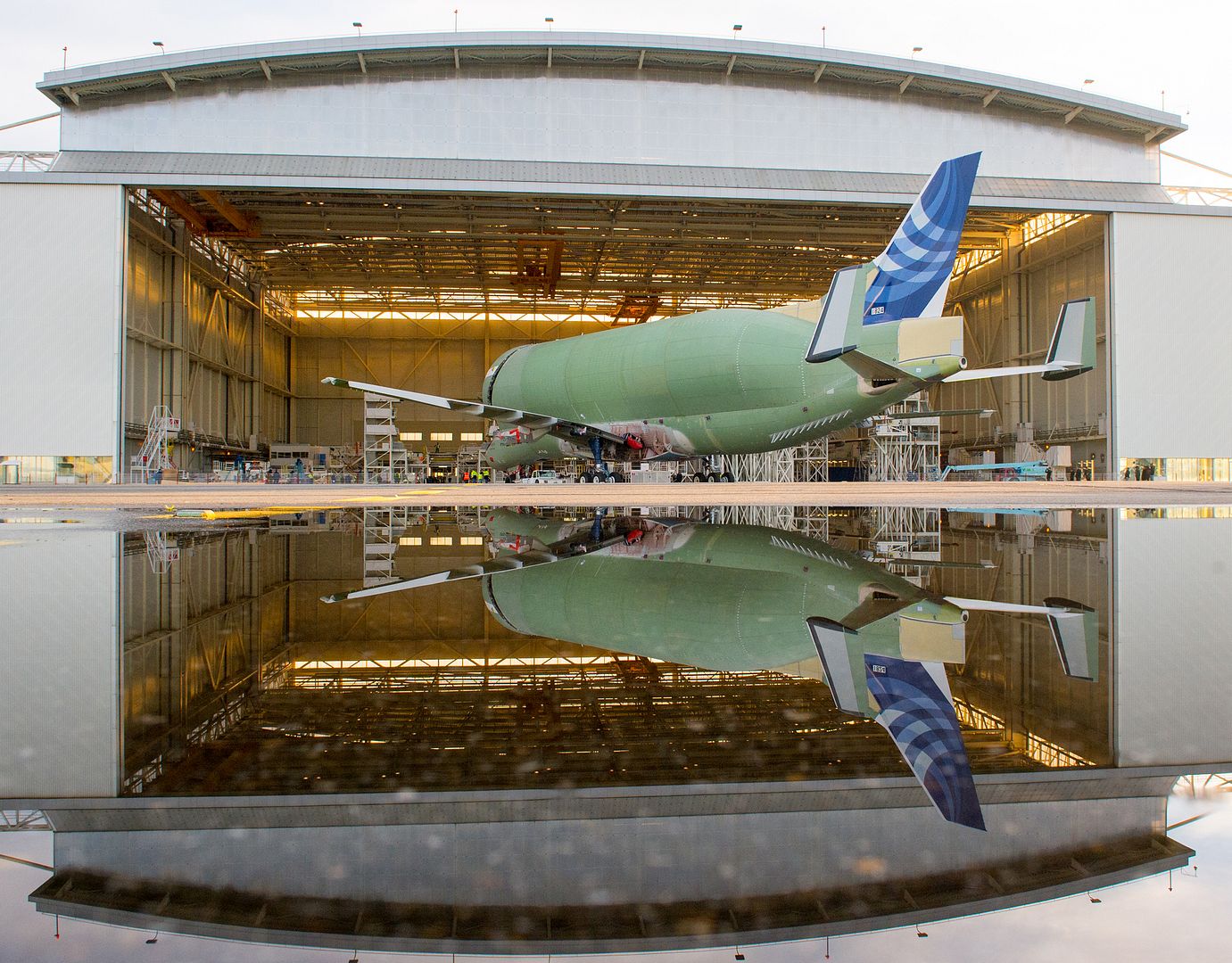
This initial BelugaXL is expected to be flying by mid-2018. ?The whole team is really looking forward to seeing its first flight and, of course, its smiling livery,? said George, referring to the supersized smile that will be painted across the ?face? of the transporter, the winning design of six options presented to Airbus employees for a vote in early 2017.
Before that can happen, the aircraft will undergo a months-long battery of tests after installation of its two jet engines, ensuring each of the BelugaXL?s systems function as intended. All the while, said George, ?We will perform bench tests in Toulouse and Hamburg, Germany ? testing our systems on flight simulators and in laboratories? as well as using hydraulic jacks to simulate flight loads on full-scale copies of specific joints between the new upper bubble and A330?s lower fuselage.
?The data from these tests will be used to clear the aircraft for flight and, later on, to attain type certification,? the official pronouncement of the aircraft?s safety and airworthiness, said George.
While the first structurally complete BelugaXL moves into its testing phase, the second A330 to be converted into a BelugaXL arrived on schedule in Toulouse to begin its integration process. George noted that with lessons learned from the production of the first transporter, the assembly time for the second is expected to be about two months shorter.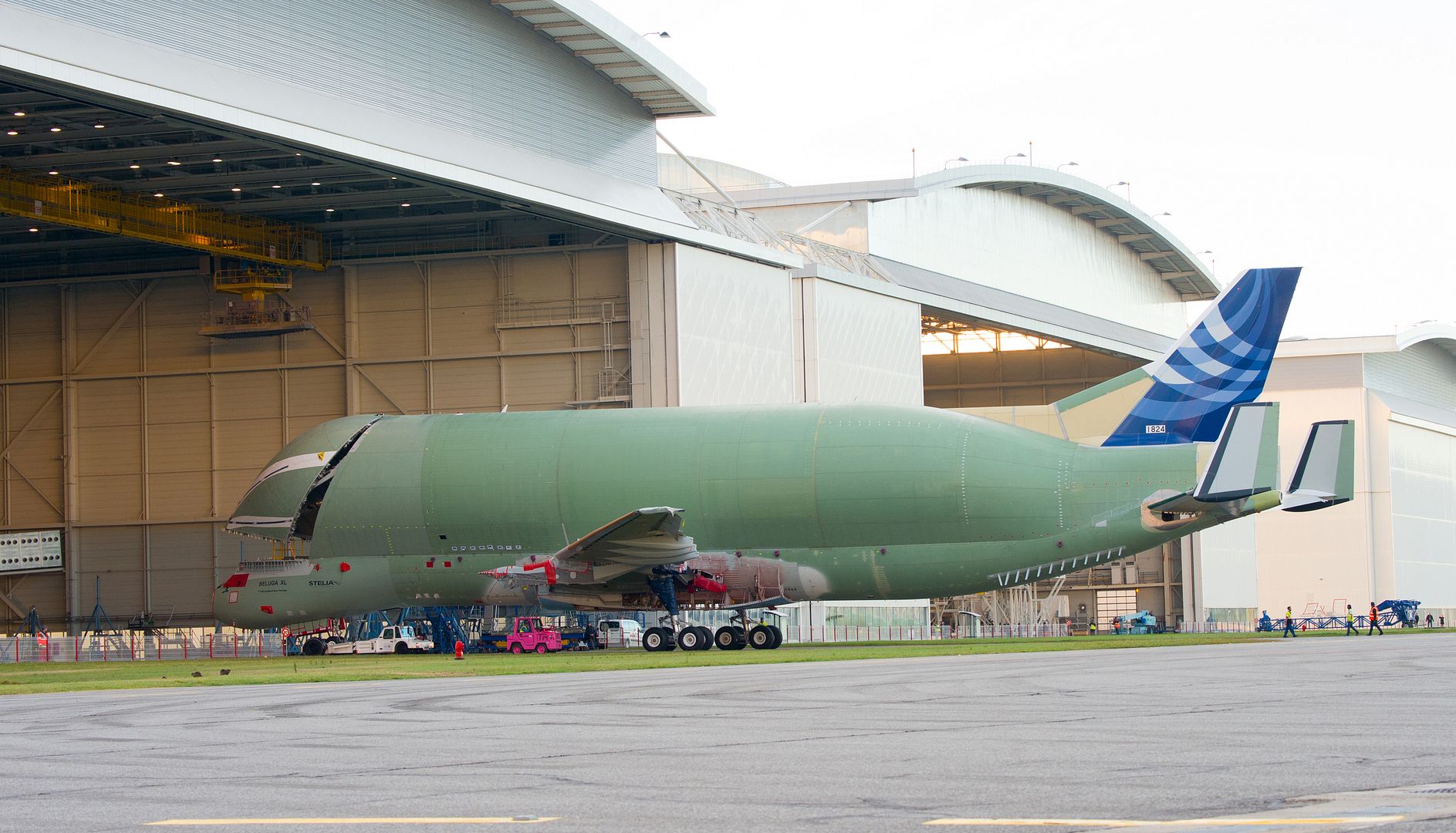
The BelugaXL programme was launched in November 2014 to address Airbus? increasing transport requirements. At six metres longer, one metre wider and with a payload lifting capacity six tonnes greater than the BelugaST transporter version it is replacing, the BelugaXL will be able to transport both wings of the A350 XWB jetliner at once, instead of the single wing currently accommodated on the BelugaST. All told, five BelugaXLs are scheduled to enter service for Airbus? airlift needs.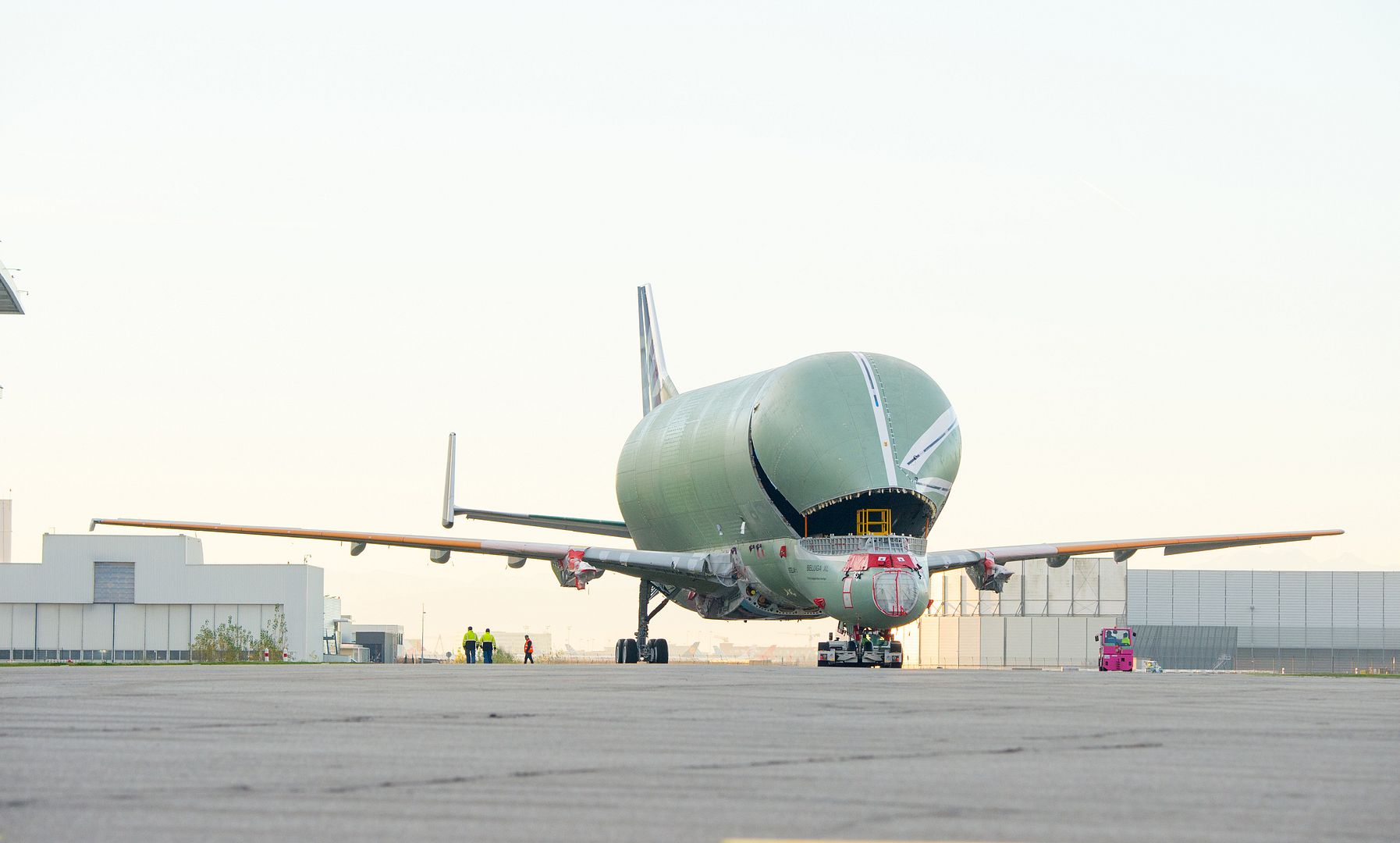
-
 Main AdminA California Army National Guard UH-60 Black Hawk helicopter takes off from Los Alamitos Army Airfield, Los Alamitos, California, Jan. 9, 2018. Two helicopters, along with their crews and rescue equipment, were activated from the airfield's flight facility to assist civil authorities with response to storm-driven mudslides in areas burned by recent wildfires in Southern California. Eight California National Guard helicopters were activated throughout the state. (U.S. Air National Guard photo by Senior Airman Crystal Housman)
Main AdminA California Army National Guard UH-60 Black Hawk helicopter takes off from Los Alamitos Army Airfield, Los Alamitos, California, Jan. 9, 2018. Two helicopters, along with their crews and rescue equipment, were activated from the airfield's flight facility to assist civil authorities with response to storm-driven mudslides in areas burned by recent wildfires in Southern California. Eight California National Guard helicopters were activated throughout the state. (U.S. Air National Guard photo by Senior Airman Crystal Housman)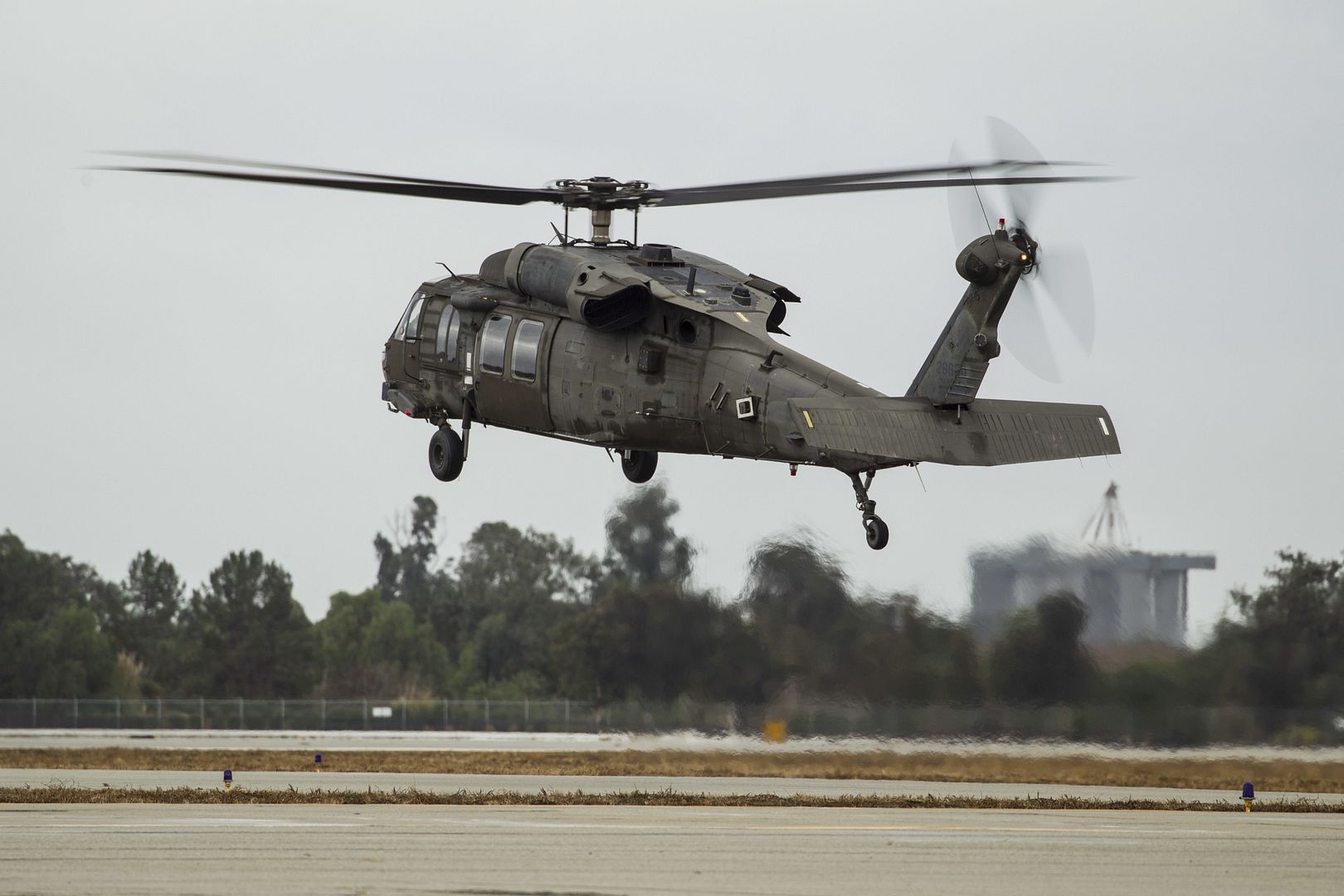
A 137th Special Operations Wing MC-12W awaits a preflight inspection at Will Rogers Air National Guard Base in Oklahoma City, Jan. 9, 2018. The MC-12 is a twin engine turbo prop aircraft used to gather intelligence, surveillance and reconnaissance to support ground forces around the world. (U.S. Air National Guard photo's by Staff Sgt. Tyler Woodward)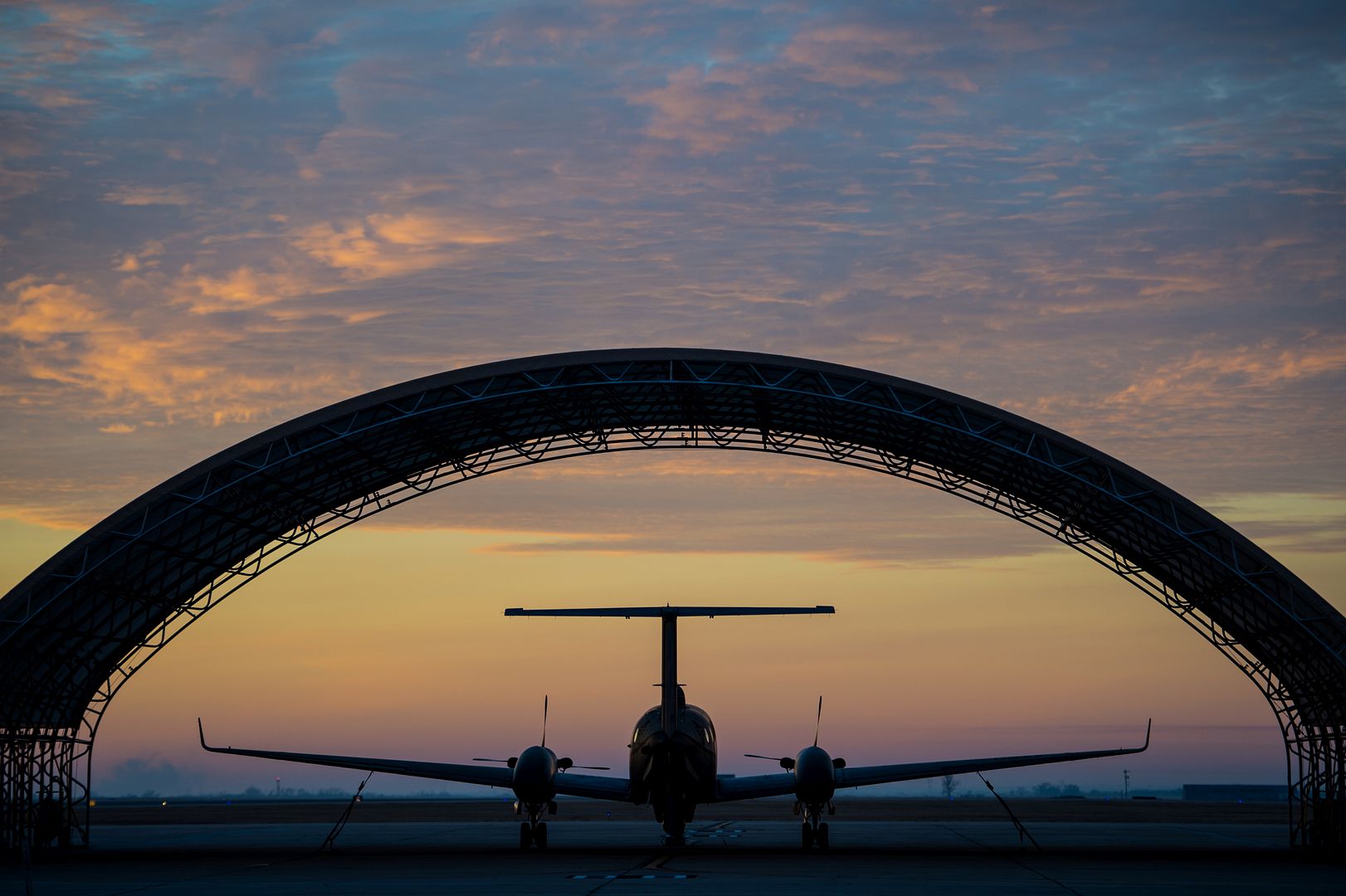
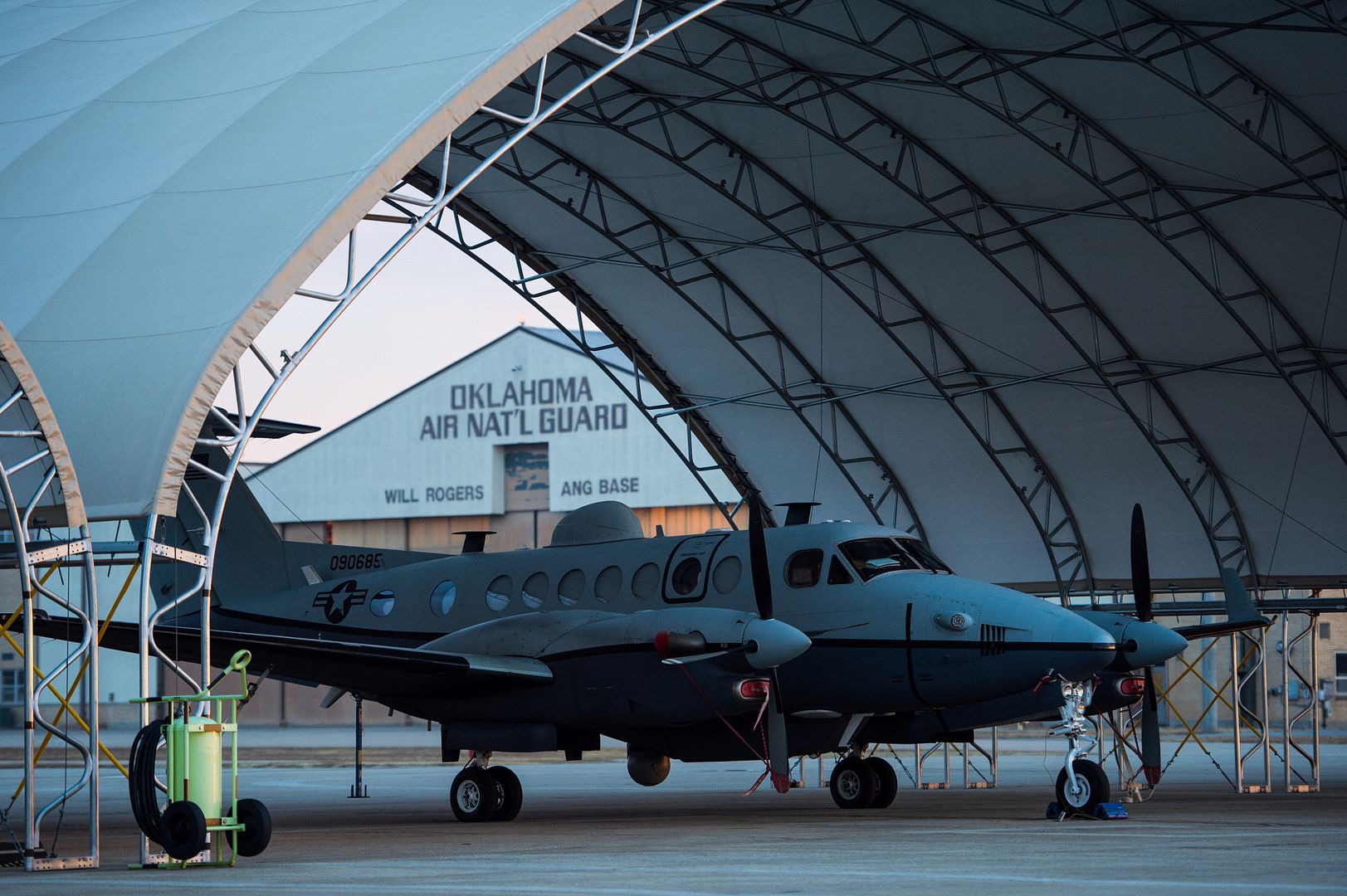
ARABIAN GULF (Jan. 9, 2018) An E-2C Hawkeye assigned to the Sunkings of Carrier Airborne Early Warning Squadron (VAW) 116 lands on the flight deck of the aircraft carrier USS Theodore Roosevelt (CVN 71). Theodore Roosevelt and its carrier strike group are deployed to the U.S. 5th Fleet area of operations in support of maritime security operations to reassure allies and partners and preserve the freedom of navigation and the free flow of commerce in the region. (U.S. Navy photo by Mass Communication Specialist 3rd Class Victoria Foley/Released)
-
 Main AdminA U.S. Air Force F-15D Eagle fighter jet from California Air National Guard?s 144th Fighter Wing taxis in after landing during Sentry Aloha 18-01 Jan. 8, 2018 at Joint Base Pearl Harbor-Hickam, Hawaii. Sentry Aloha is an ongoing series of exercises hosted by the Hawaii Air National Guard?s 154th Wing involving multiple types of aircraft and services. (Air National Guard photo by Senior Master Sgt. Chris Drudge)
Main AdminA U.S. Air Force F-15D Eagle fighter jet from California Air National Guard?s 144th Fighter Wing taxis in after landing during Sentry Aloha 18-01 Jan. 8, 2018 at Joint Base Pearl Harbor-Hickam, Hawaii. Sentry Aloha is an ongoing series of exercises hosted by the Hawaii Air National Guard?s 154th Wing involving multiple types of aircraft and services. (Air National Guard photo by Senior Master Sgt. Chris Drudge)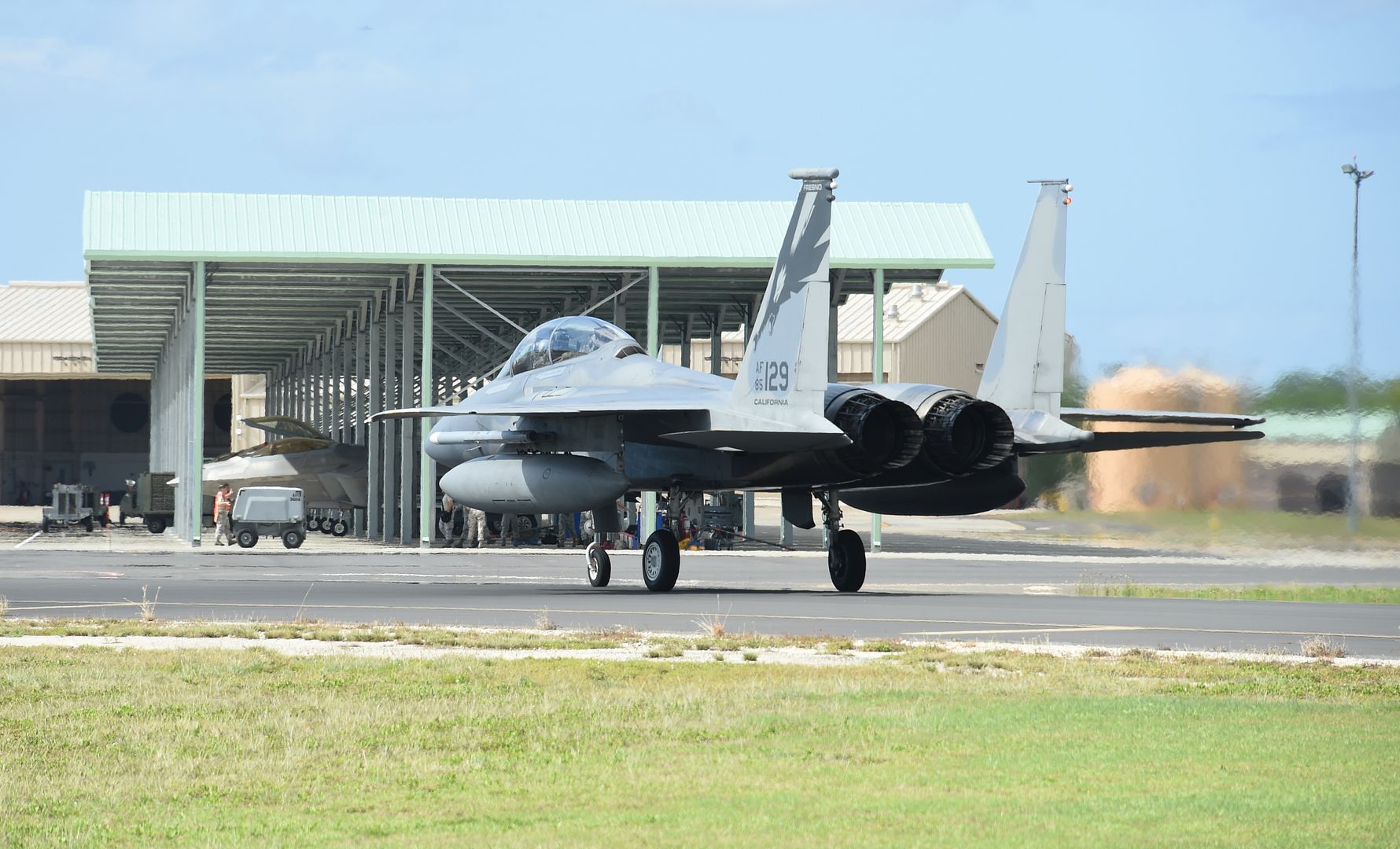
U.S. Air Force Senior Airman Adriana Wright, 144th Fighter Wing, marshals an F-15C Eagle fighter jet from the 144th FW at Joint Base Pearl Harbor-Hickam, Hawaii prior to Sentry Aloha 18-01 Jan. 8, 2018. Sentry Aloha provides tailored, cost effective and realistic combat training for U.S. Air Force, Air National Guard and other Department of Defense services to provide U.S. warfighters with the skill sets necessary to perform their homeland defense and overseas combat missions. (Air National Guard photo by Senior Master Sgt. Chris Drudge)
KC-135 aircraft parked on the ramp of the Pennsylvania Air National Guard?s 171st Air Refueling Wing near Pittsburgh Jan. 11, 2018. (U.S. Air National Guard Photo's by Senior Master Sgt. Shawn Monk)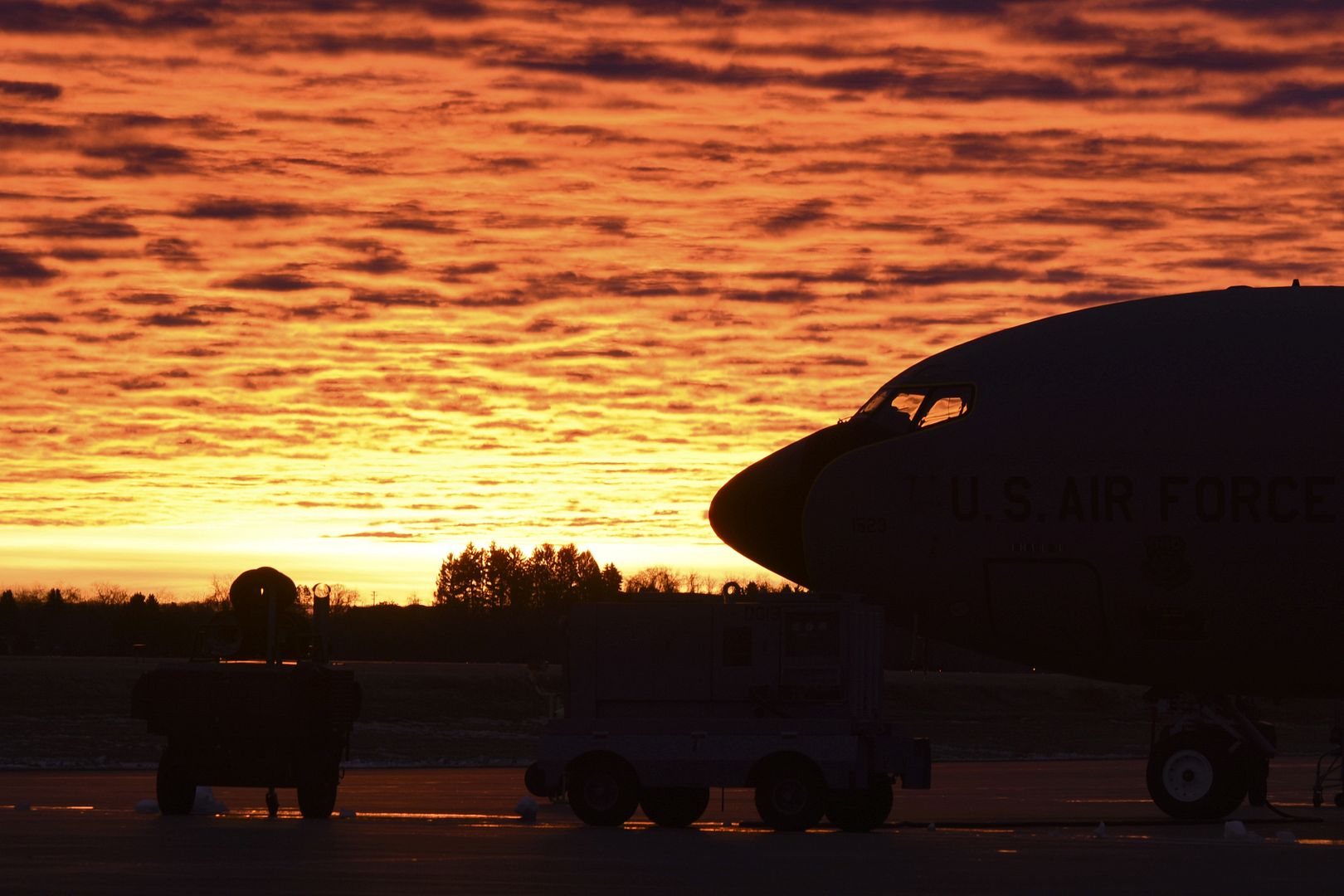
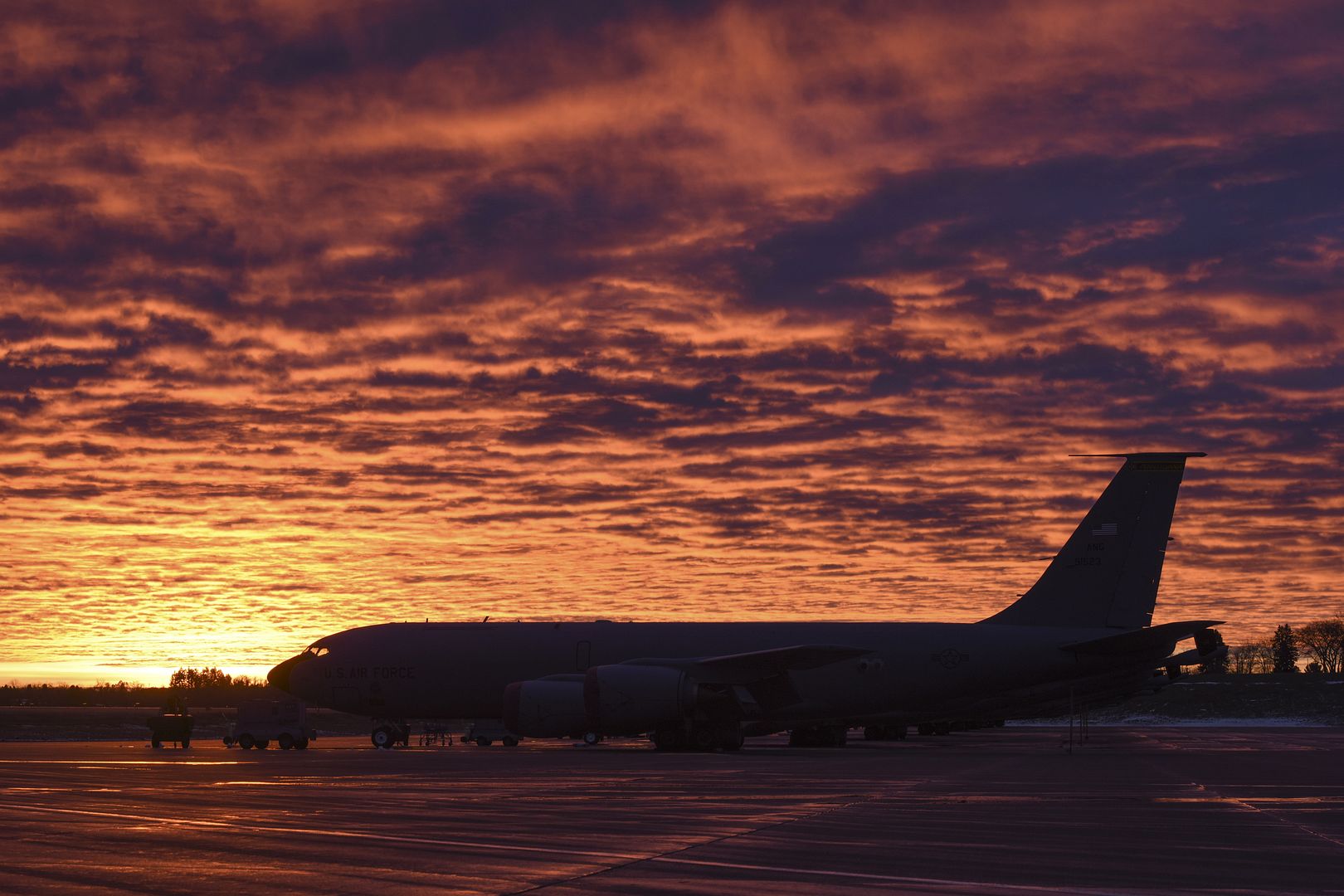
A Wyoming Air National Guard C-130H modified with T-56 Rolls-Royce 3.5 engines, electronic propeller controls and NP2000 eight-bladed propellers takes off, Jan. 11, 2017 at Cheyenne Regional Airport in Cheyenne Wyoming. The one-of-a-kind C-130 will be testing at Eglin Air Force Base in Florida for the next 18 months. (U.S. Air National Guard photo's by Senior Master Sgt. Charles Delano)
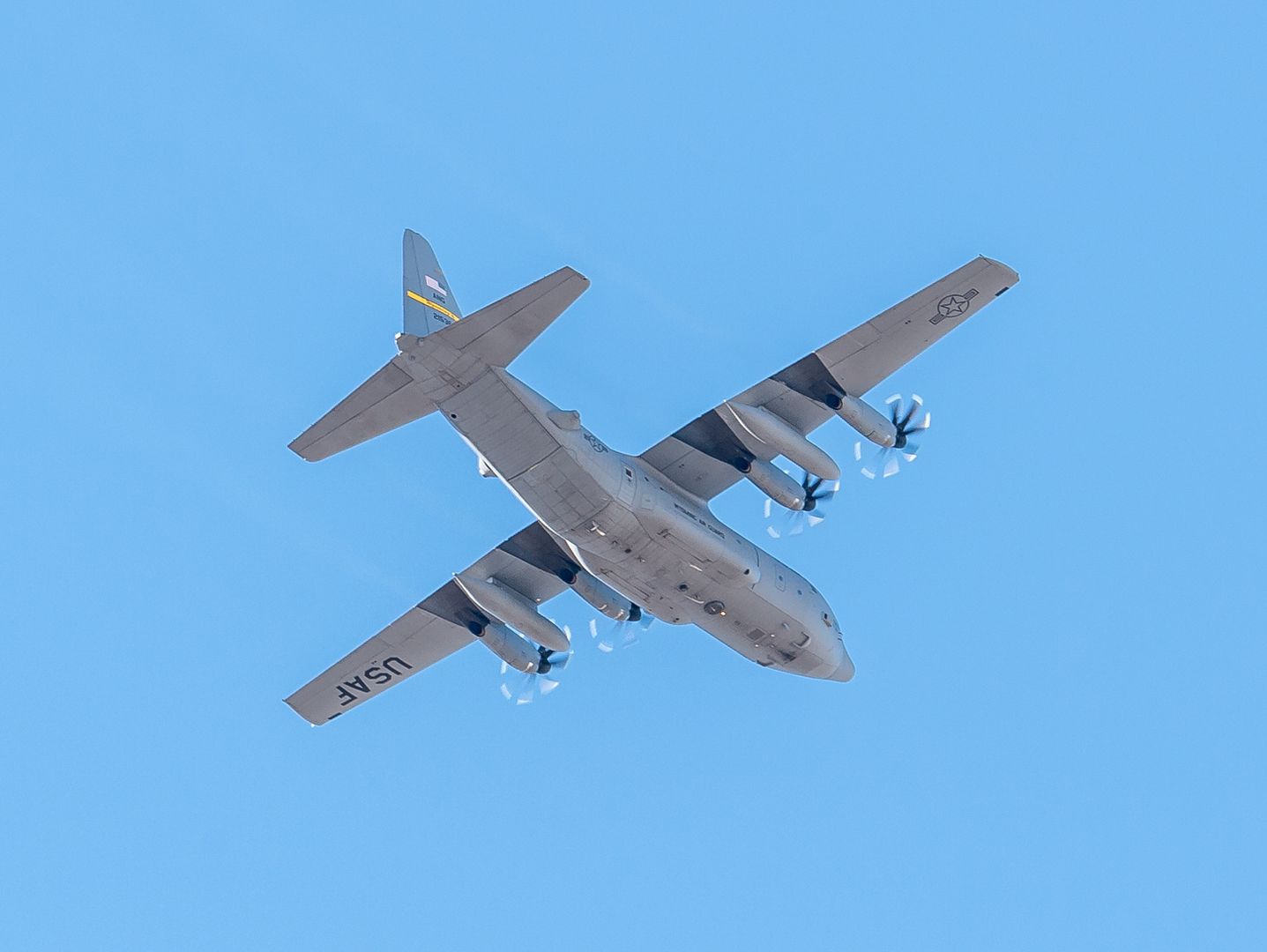
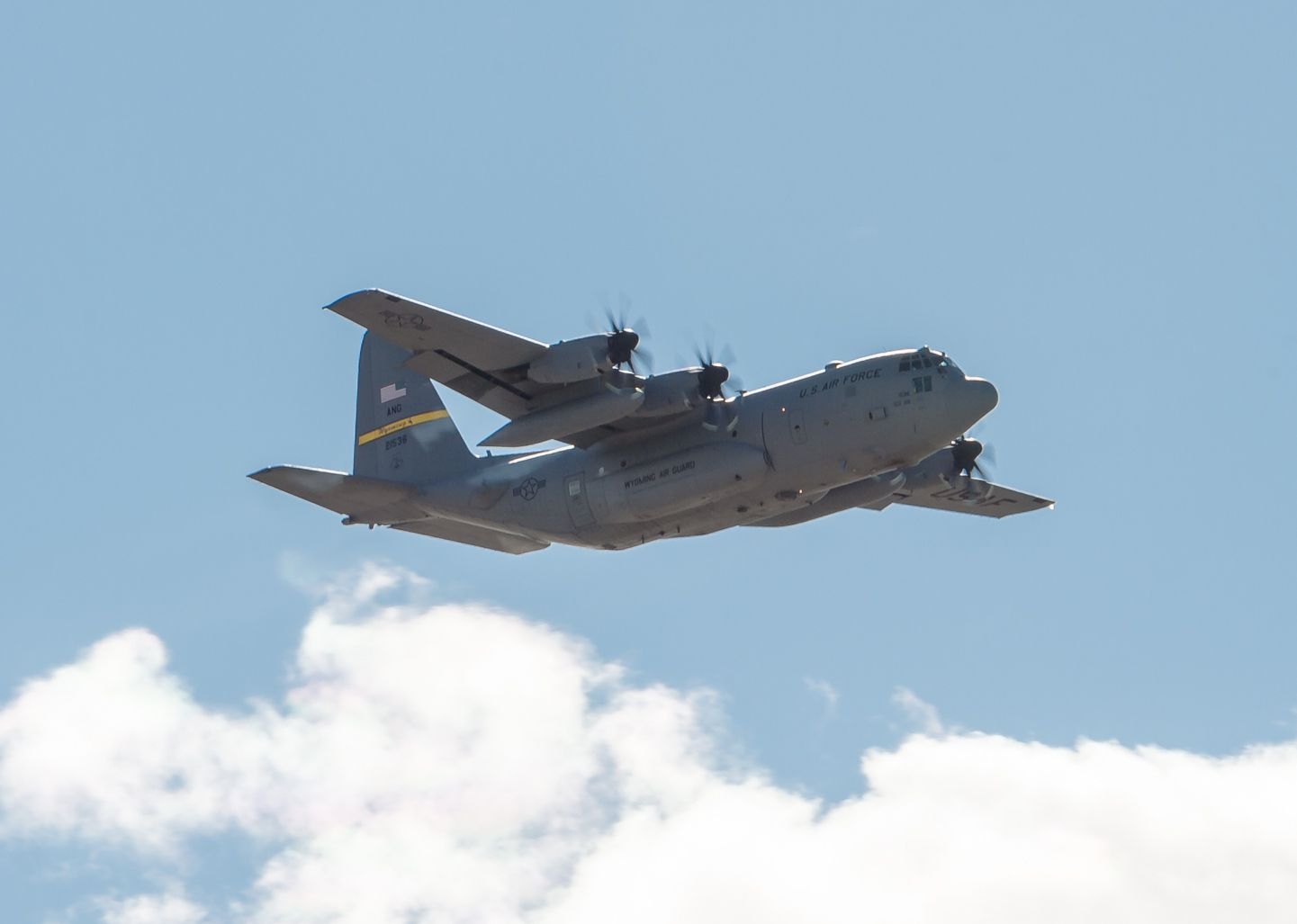
A B-52H Stratofortress assigned to Air Force Global Strike Command deploys its drauge parachute at RAF Fairford, England, Jan. 9, 2018. Aircraft, Airmen and support equipment from the 5th Bomb Wing, Minot Air Force Base, N.D., deployed to RAF Fairford, to conduct theater integration and flying training. (U.S. Air Force photo by Senior Airman J.T. Armstrong)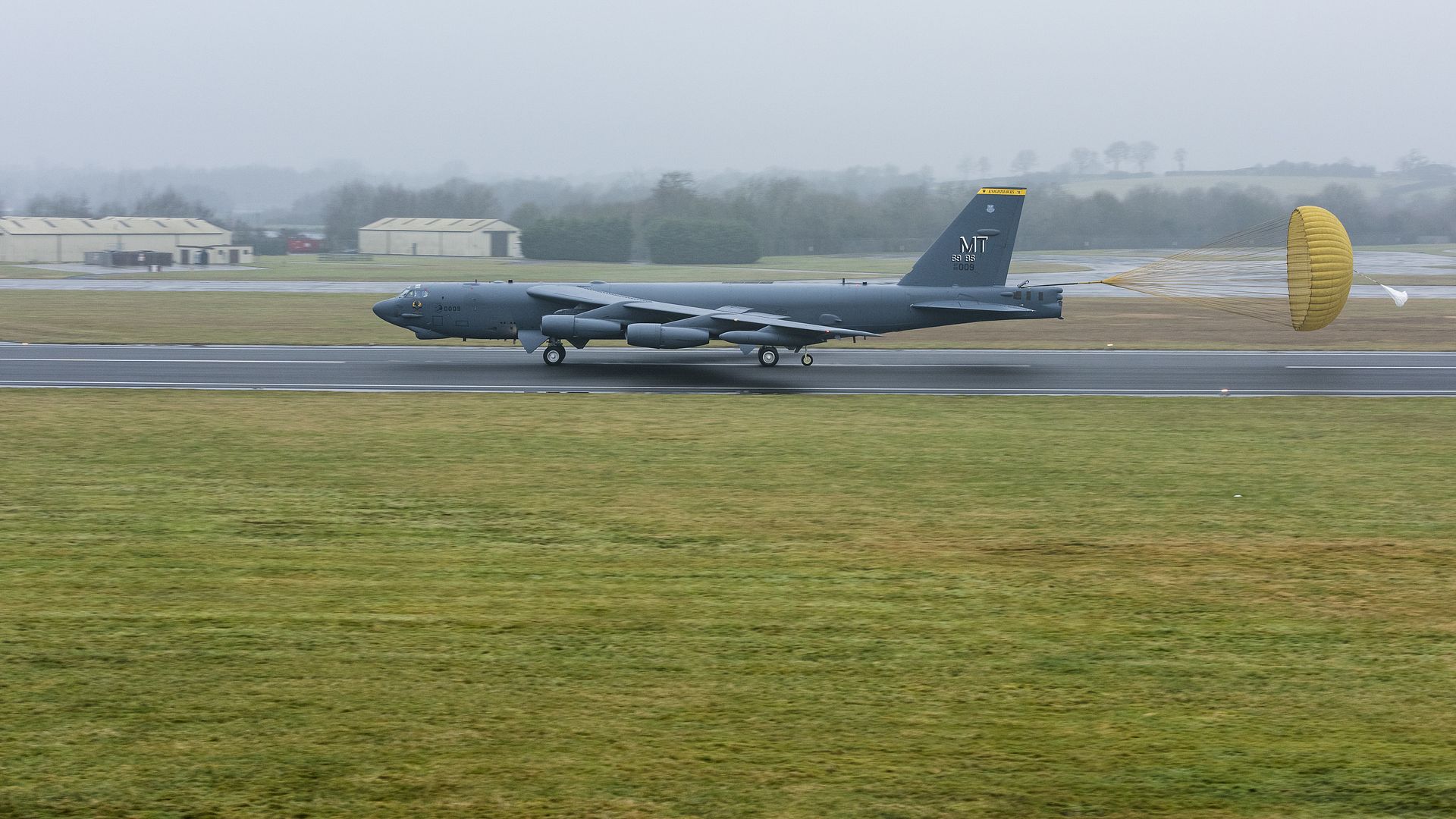
A B-52H Stratofortress assigned to Air Force Global Strike Command flies over RAF Fairford, England, Jan. 10, 2018. The deployment of strategic bombers to RAF Fairford helps exercise the base as United States Air Forces in Europe?s forward operating location for bombers. (U.S. Air Force photo by Senior Airman J.T. Armstrong)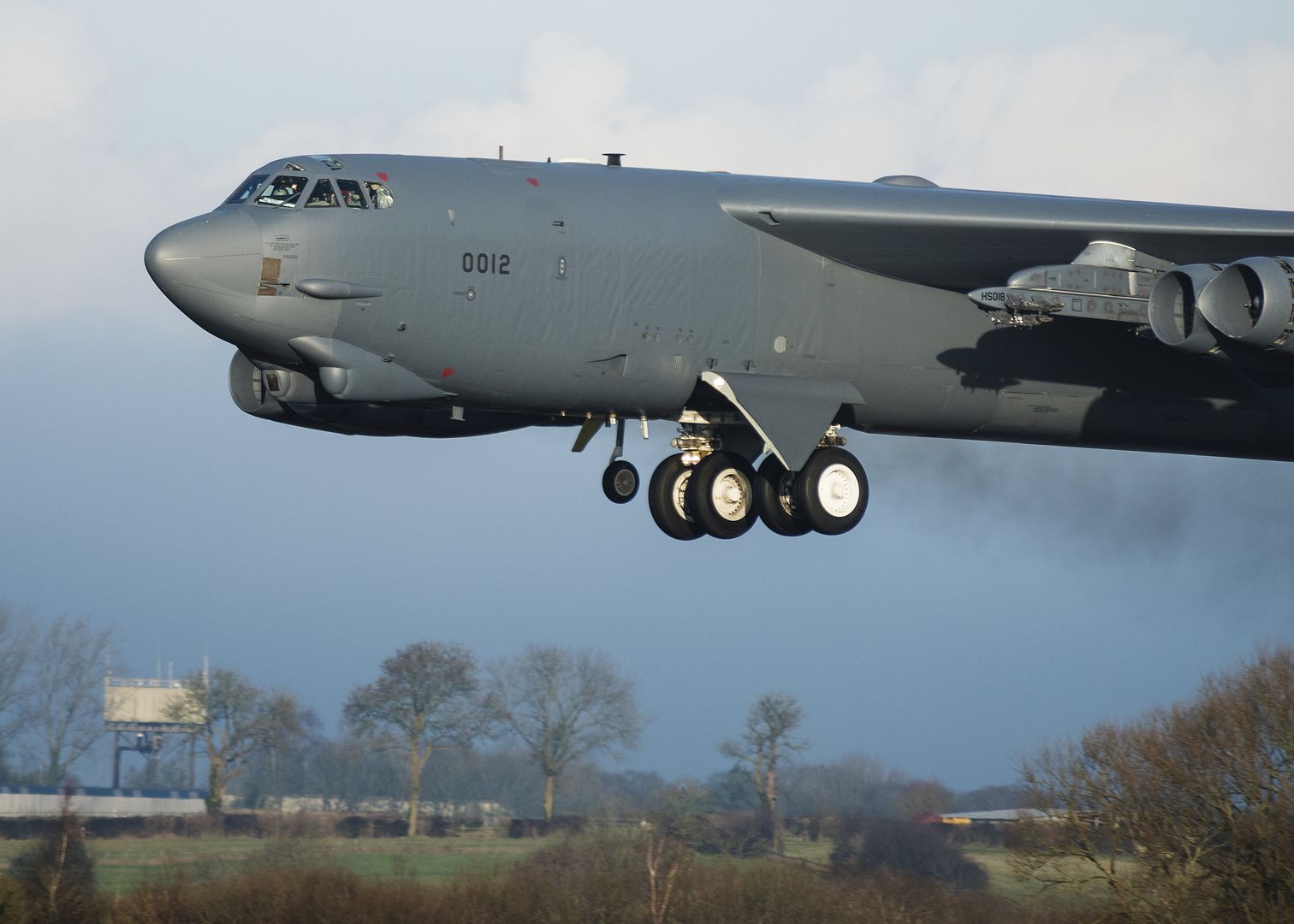
A B-52H Stratofortress assigned to Air Force Global Strike Command taxis at RAF Fairford, England, Jan. 10, 2018. Aircraft, Airmen and support equipment from the 5th Bomb Wing, Minot Air Force Base, N.D., deployed to RAF Fairford, to conduct theater integration and flying training. (U.S. Air Force photo by Senior Airman J.T. Armstrong)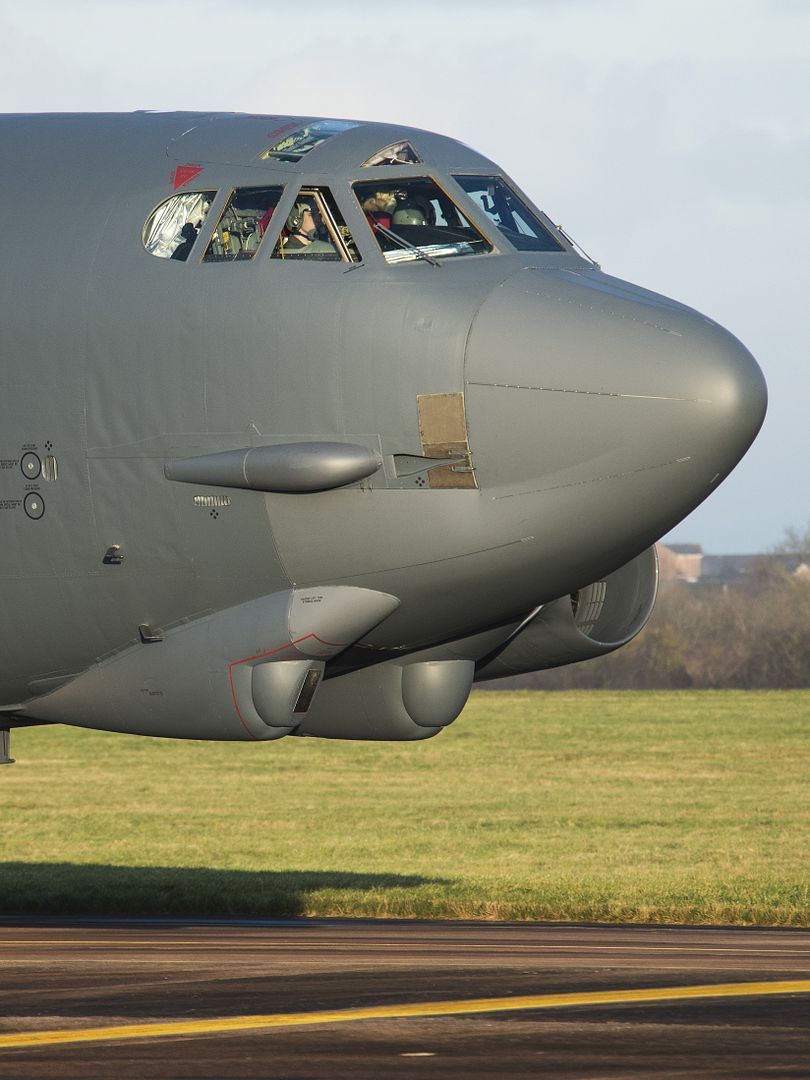
A B-52H Stratofortress assigned to Air Force Global Strike Command deploys its drauge parachute at RAF Fairford, England, Jan. 10, 2018. The deployment of strategic bombers to RAF Fairford helps exercise the base as United States Air Forces in Europe?s forward operating location for bombers. (U.S. Air Force photo by Senior Airman J.T. Armstrong)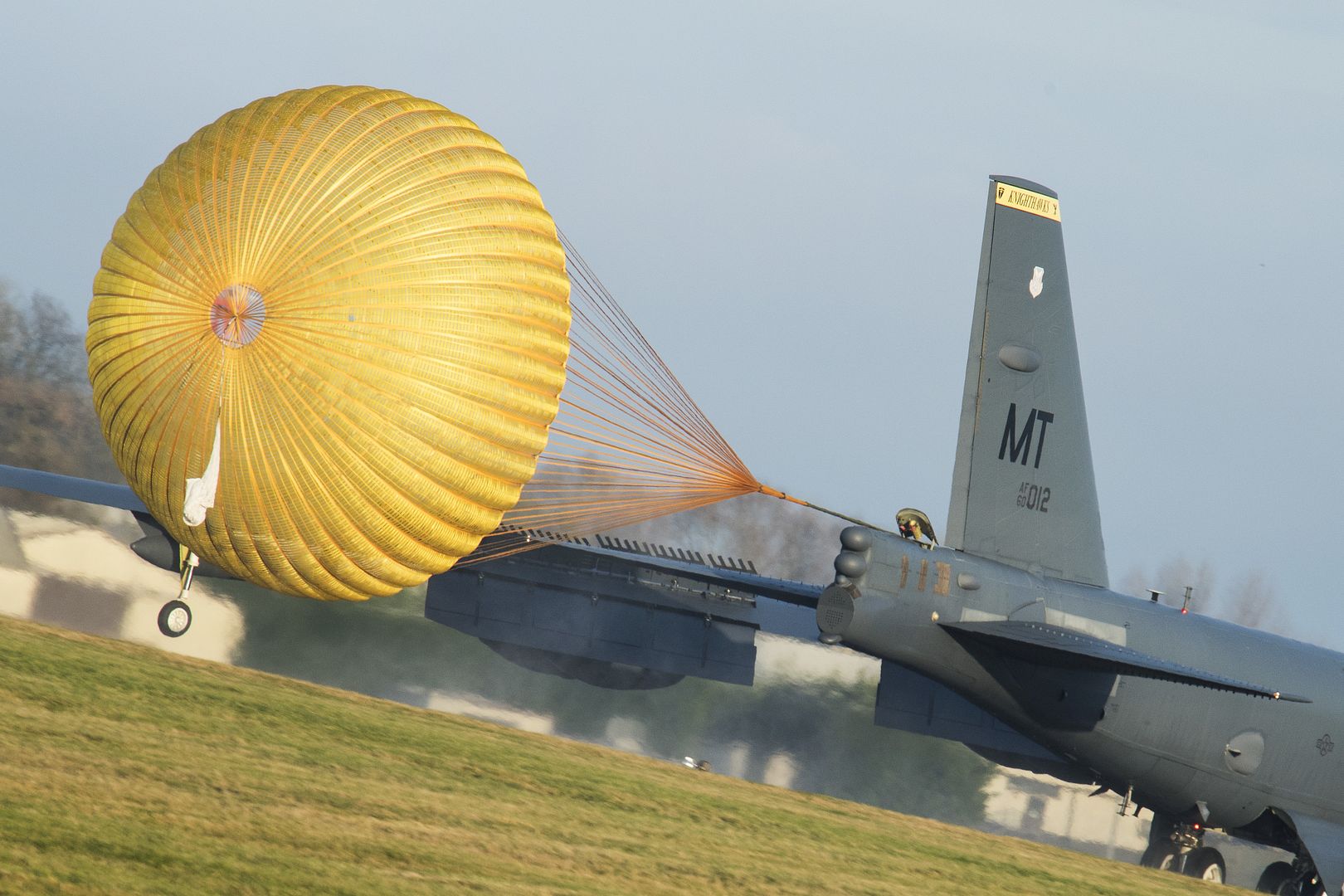
CAPE CANAVERAL AIR FORCE STATION, Fla., Jan. 11, 2018 /PRNewswire/ -- The U.S. Air Force's fourth Space Based Infrared System (SBIRS) Geosynchronous Earth Orbit (GEO) satellite built by Lockheed Martin (NYSE: LMT) was encapsulated on Jan. 9. The SBIRS GEO Flight-4 satellite is now ready for its planned Jan. 18 launch from Cape Canaveral Air Force Station, Florida, on a United Launch Alliance Atlas V rocket.
During encapsulation, SBIRS GEO Flight-4 was sealed in its launch fairing, an aerodynamic, nose-cone shell that protects the satellite during launch. In the coming days, the fairing with the satellite enclosed will be mounted on top of the Atlas V rocket as launch preparations continue.
SBIRS GEO Flight-4 is the latest satellite to join the Air Force's orbiting network of satellites equipped with powerful scanning and staring infrared surveillance sensors. The sensors collect data for use by the U.S. military to detect missile launches, support ballistic missile defense, expand technical intelligence gathering and bolster situational awareness on the battlefield.
Back on the ground, a sophisticated new SBIRS ground control system serves as the nerve center for the entire SBIRS satellite constellation and receives large amounts of data from the satellites' powerful sensors. The SBIRS control system and its operators convert this data into actionable reports for defense, intelligence and civil applications.
"SBIRS provides our military with timely, reliable and accurate missile warning and infrared surveillance information," said Tom McCormick, vice president of Lockheed Martin's Overhead Persistent Infrared systems mission area. "We look forward to adding GEO Flight-4's capabilities to the first line of defense in our nation's missile defense strategy."
Lockheed Martin manufactured the SBIRS GEO Flight-4 satellite at its Sunnyvale, California, facility. The satellite was delivered to Florida on Oct. 31, 2017.
Building on SBIRS
The Air Force's SBIRS program continues to grow resilient, persistent, space-based infrared surveillance capabilities.
The planned launch of SBIRS GEO Flight-4 comes just 12 months after the launch of SBIRS GEO Flight-3, which in March 2017 sent its first images back down to Earth in a milestone known as "first light." These two satellites join SBIRS' GEO-1 and GEO-2, which received Air Force Space Command Operational Acceptance in 2013, and have performance that matches, and in some cases exceeds, requirements.
The next SBIRS satellites, GEO-5 and GEO-6, will bring increased resiliency, production efficiency and the ability to add new advanced sensor suites to the constellation using Lockheed Martin's modernized LM 2100 satellite bus. In September, a system Critical Design Review for the modernized design for GEO 5 and 6 was conducted with the Air Force, authorizing the satellites to enter into the manufacturing and integration phase.
At the center of SBIRS is its ground control system, which receives and processes a vast amount of satellite data. In late 2016, the Air Force operationally accepted "SBIRS Block 10," a new control system developed by Lockheed Martin, which includes enhancements like faster data collection times, improved threat detections, and improved target tracking and infrared information to enable troops to see dimmer targets faster.
SBIRS Block 10 also provides the Air Force with greater efficiency by consolidated ground control for the legacy Defense Support Program, as well as SBIRS satellites and payloads in GEO and Highly Elliptical Orbits.
For additional SBIRS information, photos and video visit: www.lockheedmartin.com/sbirs.
-
 Main AdminA C-130J Super Hercules lands at Yokota Air Base, Japan, Jan 10, 2018. Yokota has received its tenth C-130J from Dyess Air Force Base, Texas, as part of fleet-wide redistribution of assets set in motion by Air Mobility Command. (U.S. Air Force photo by Yasuo Osakabe)
Main AdminA C-130J Super Hercules lands at Yokota Air Base, Japan, Jan 10, 2018. Yokota has received its tenth C-130J from Dyess Air Force Base, Texas, as part of fleet-wide redistribution of assets set in motion by Air Mobility Command. (U.S. Air Force photo by Yasuo Osakabe)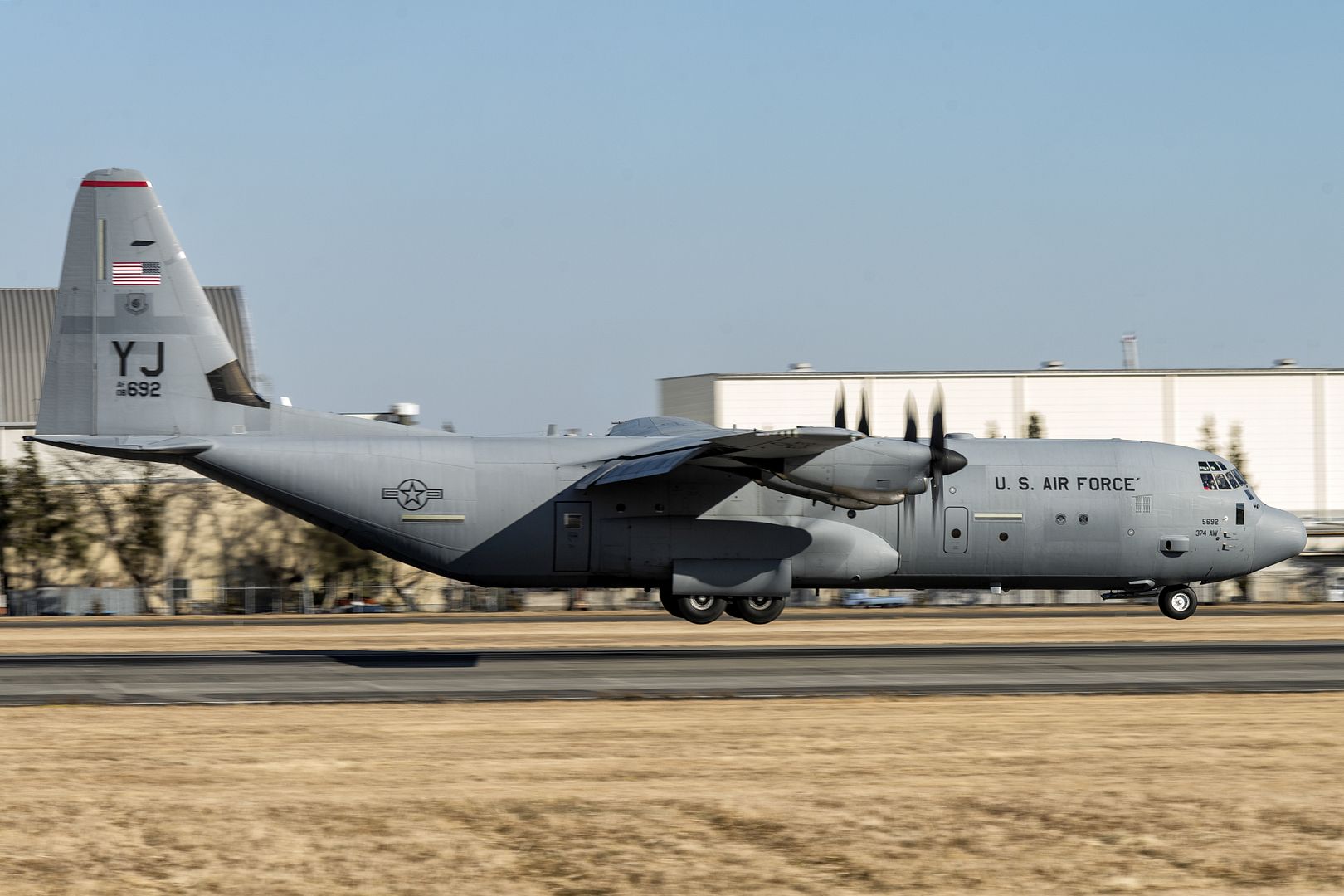
U.S. Air Force F-15C Eagle fighter jets from the California Air National Guard?s 144th Fighter Wing are prepped for the first day of flying during Sentry Aloha 18-01 Jan. 10, 2018 at Joint Base Pearl Harbor-Hickam, Hawaii. Sentry Aloha provides tailored, cost effective and realistic combat training for U.S. Air Force, Air National Guard and other Department of Defense services to provide U.S. warfighters with the skill sets necessary to perform their homeland defense and overseas combat missions. (Air National Guard photo's by Senior Master Sgt. Chris Drudge)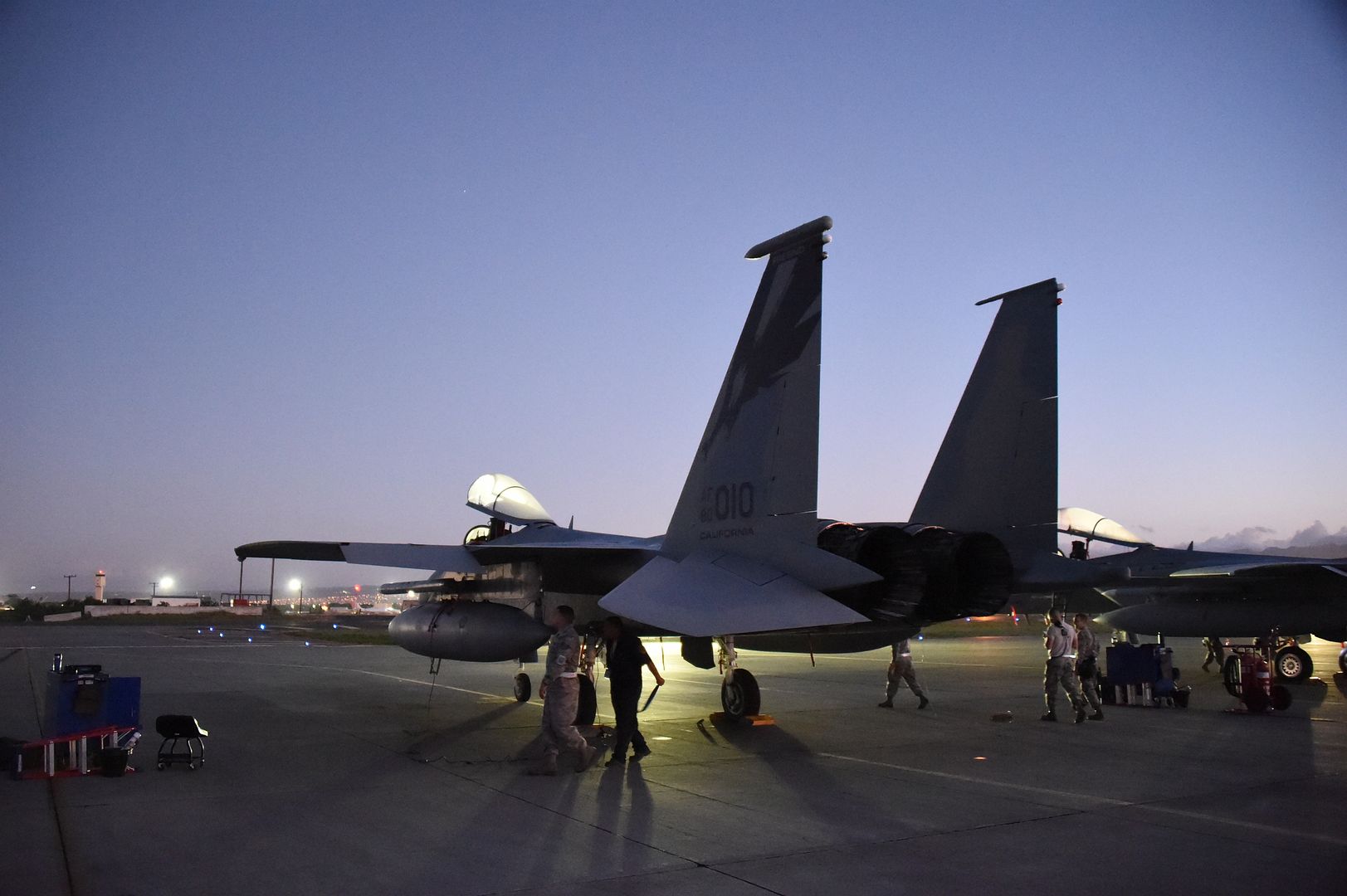
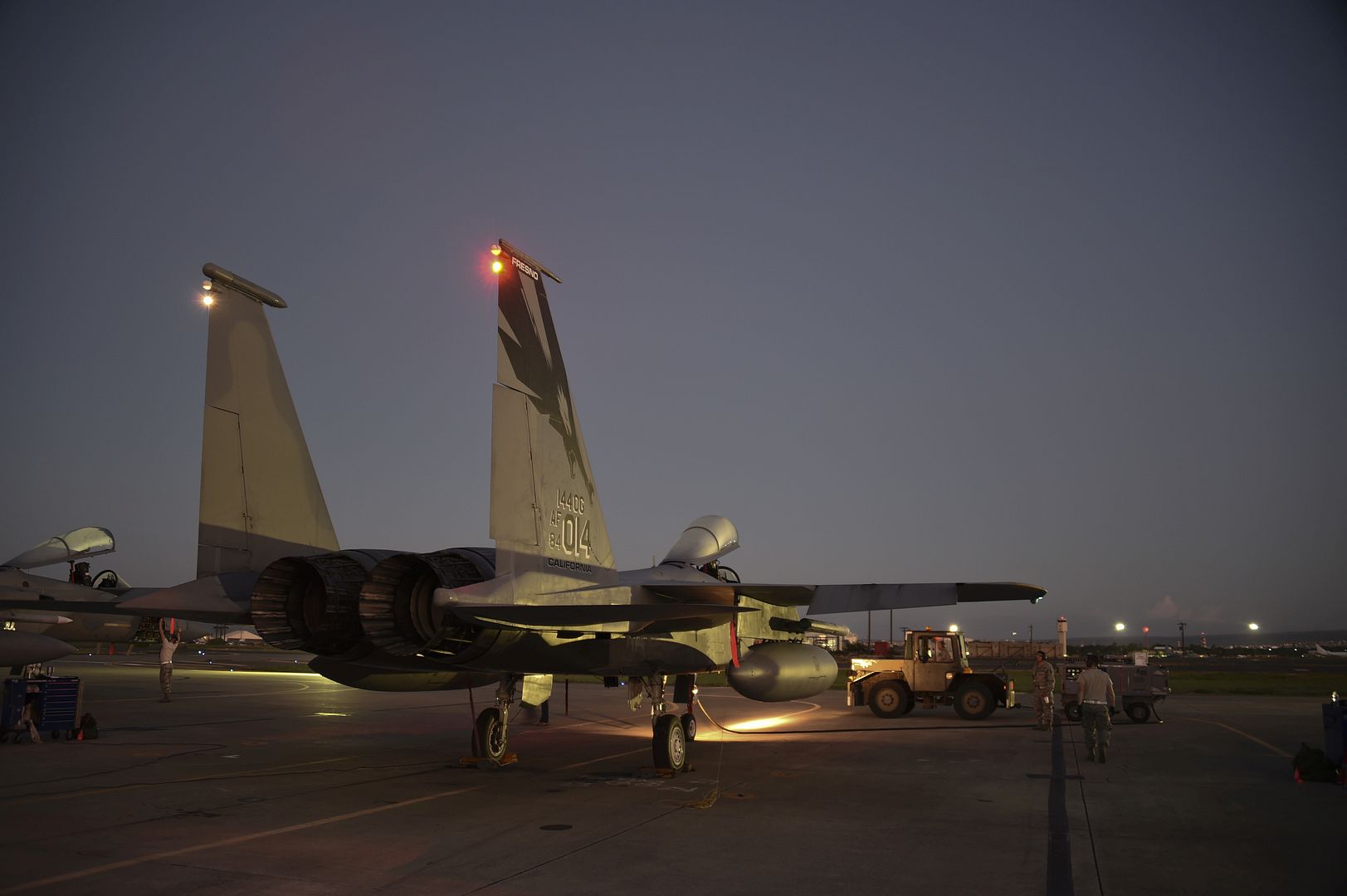
A B-52 Stratofortress arrives at RAF Fairford, England, on Jan. 10, 2018. RAF Fairford serves as United States Air Forces in Europe's forward operating location for bombers. (U.S. Air Force photo by Staff Sgt. Trevor T. McBride)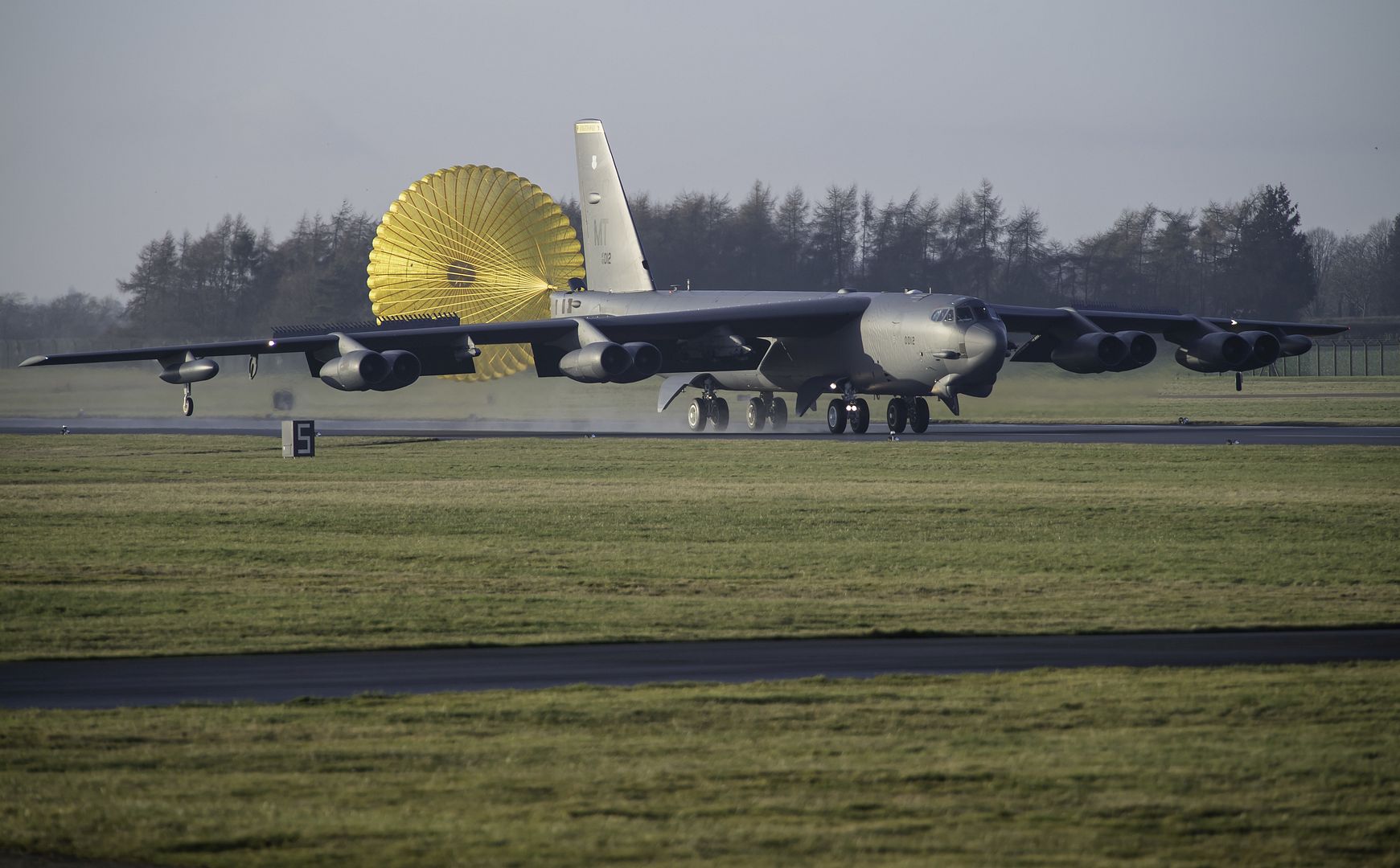
An F-15E Strike Eagle takes off during exercise Thunderdome 18-01, Jan. 11, 2018, at Seymour Johnson Air Force Base, North Carolina. Thunderdome is designed to keep Airmen in a warrior mindset and sharpen tactics, techniques and procedures to prevent unnecessary loss of life or injury in the event of a real-world incident. (U.S. Air Force photo by Airman 1st Class Kenneth Boyton)
An MH-65 Dolphin rescue helicopter crew medevacs an ill fisherman from the deck of the Coast Guard Cutter Willow approximately 60-miles east of Atlantic City, New Jersey, Jan. 11, 2017.
The crew of the fishing vessel Illusion reported a crewmember reportedly suffering respiratory related issues
Once onboard the helicopter, the man was transported to Atlanticare Regional Medical Center in Atlantic City, New Jersey.
U.S. Coast Guard photo by crew of CGC Willow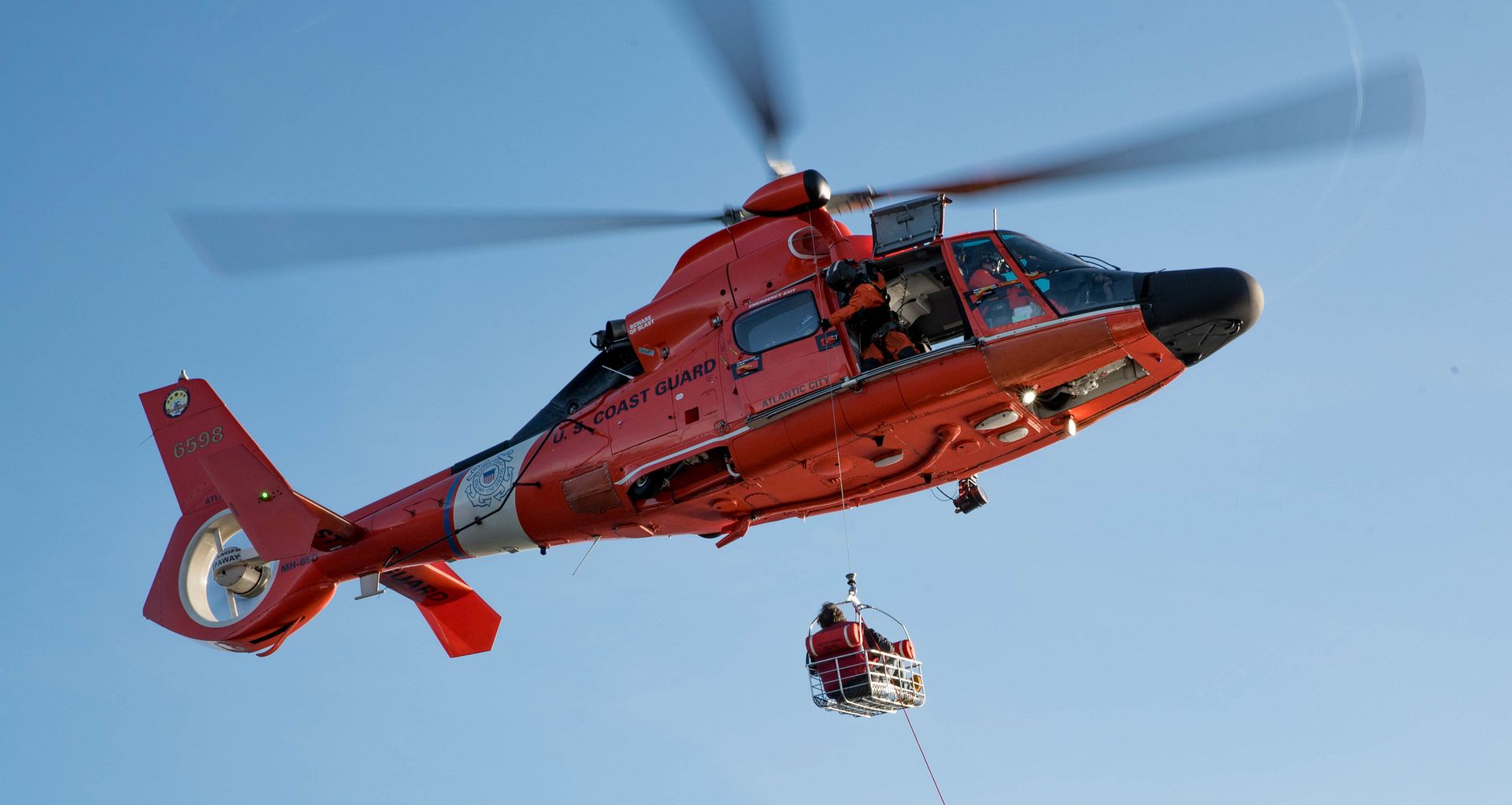
-
 Main AdminTwo U.S. Air Force F-15C Eagle fighter jets from California Air National Guard?s 144th Fighter Wing return to base during Sentry Aloha 18-01 at Joint Base Pearl Harbor-Hickam, Hawaii Jan. 11, 2018. Sentry Aloha provides tailored, cost effective and realistic combat training for U.S. Air Force, Air National Guard and other Department of Defense services to provide U.S. warfighters with the skill sets necessary to perform their homeland defense and overseas combat missions. (Air National Guard photo by Senior Master Sgt. Chris Drudge)
Main AdminTwo U.S. Air Force F-15C Eagle fighter jets from California Air National Guard?s 144th Fighter Wing return to base during Sentry Aloha 18-01 at Joint Base Pearl Harbor-Hickam, Hawaii Jan. 11, 2018. Sentry Aloha provides tailored, cost effective and realistic combat training for U.S. Air Force, Air National Guard and other Department of Defense services to provide U.S. warfighters with the skill sets necessary to perform their homeland defense and overseas combat missions. (Air National Guard photo by Senior Master Sgt. Chris Drudge)
U.S. Air Force F-15C Eagle fighter jets from California Air National Guard?s 144th Fighter Wing stand ready for the morning mission during Sentry Aloha 18-01 at Joint Base Pearl Harbor-Hickam, Hawaii Jan. 11, 2018. Sentry Aloha provides tailored, cost effective and realistic combat training for U.S. Air Force, Air National Guard and other Department of Defense services to provide U.S. warfighters with the skill sets necessary to perform their homeland defense and overseas combat missions. (Air National Guard photo by Senior Master Sgt. Chris Drudge)
ATLANTIC OCEAN (Jan. 13, 2018) -- An F/A-18F Super Hornet, assigned to the "Black Lions" of Strike Fighter Squadron (VFA) 213, prepares to land on the flight deck of USS Gerald R. Ford (CVN 78). Ford is underway conducting test and evaluation operations. (U.S. Navy photo by Mass Communication Specialist 3rd Class Ryan Carter)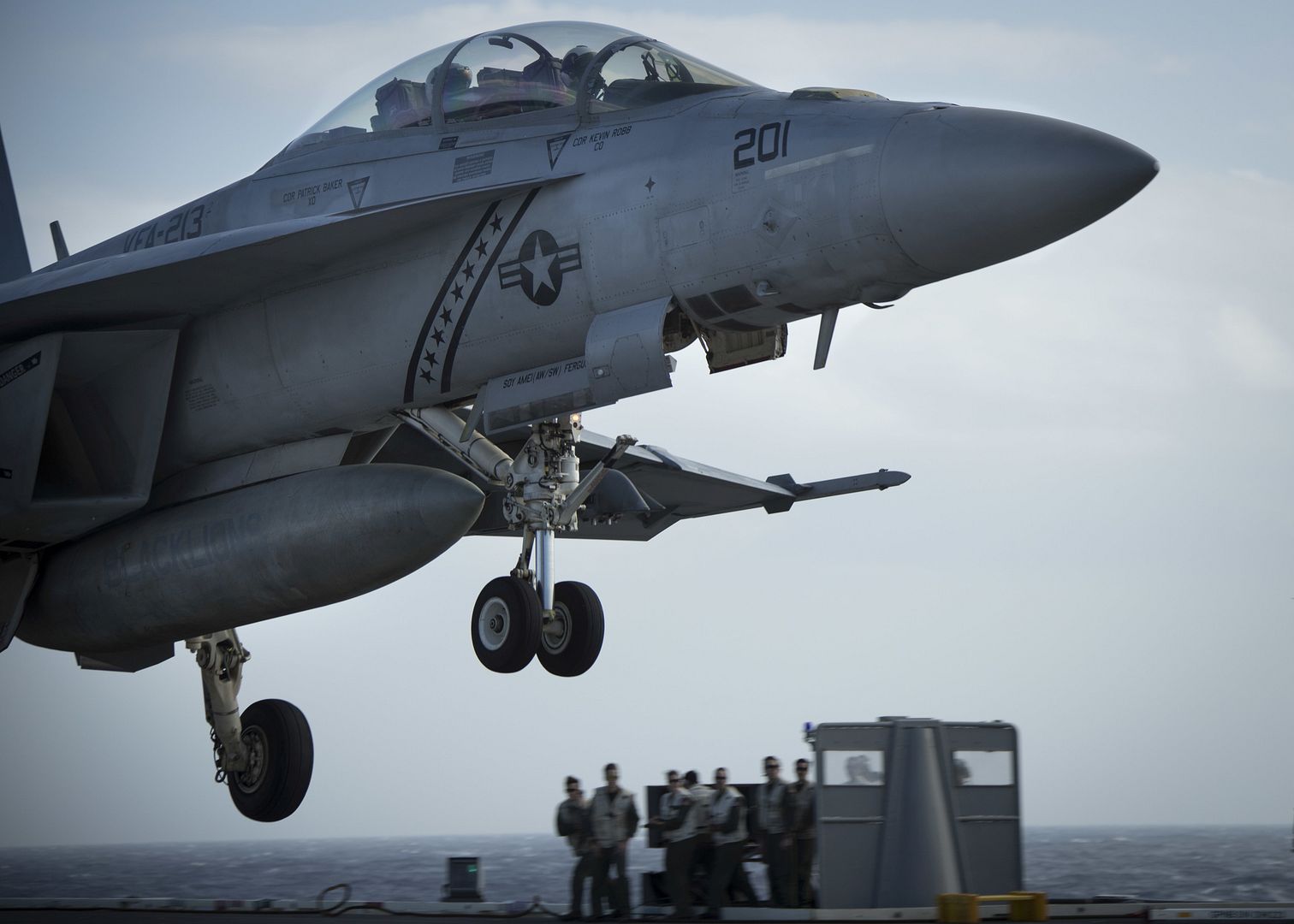
ATLANTIC OCEAN (Jan. 13, 2018) -- An F/A-18E Super Hornet, assigned to the "Tomcatters" of Strike Fighter Squadron (VFA) 31, preforms a touch and go on the flight deck of USS Gerald R. Ford (CVN 78). Ford is underway conducting test and evaluation operations. (U.S. Navy photo by Mass Communication Specialist 3rd Class Ryan Carter)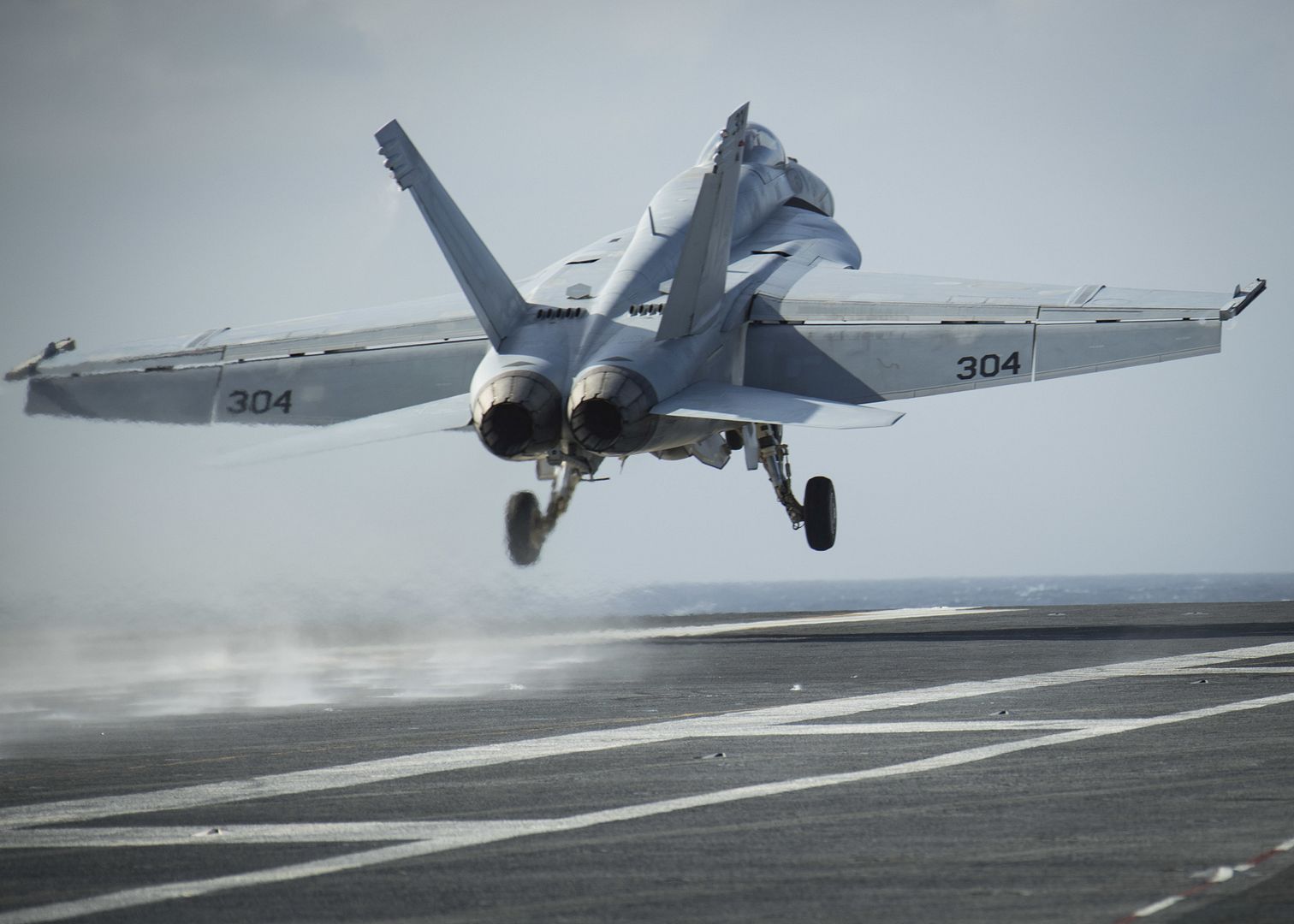
-
 Main AdminF-16s from the 180th Fighter Wing, Ohio Air National Guard, park on the ramp at Amari Air Base, Estonia, after arriving January 14th, 2018. The twelve F-16s are part of a theater security package that highlights the U.S.?s ability to deploy fighter aircraft in support of our partners and allies in the European theater, and around the world. (DoD photo by MC3 Cody Hendrix)
Main AdminF-16s from the 180th Fighter Wing, Ohio Air National Guard, park on the ramp at Amari Air Base, Estonia, after arriving January 14th, 2018. The twelve F-16s are part of a theater security package that highlights the U.S.?s ability to deploy fighter aircraft in support of our partners and allies in the European theater, and around the world. (DoD photo by MC3 Cody Hendrix)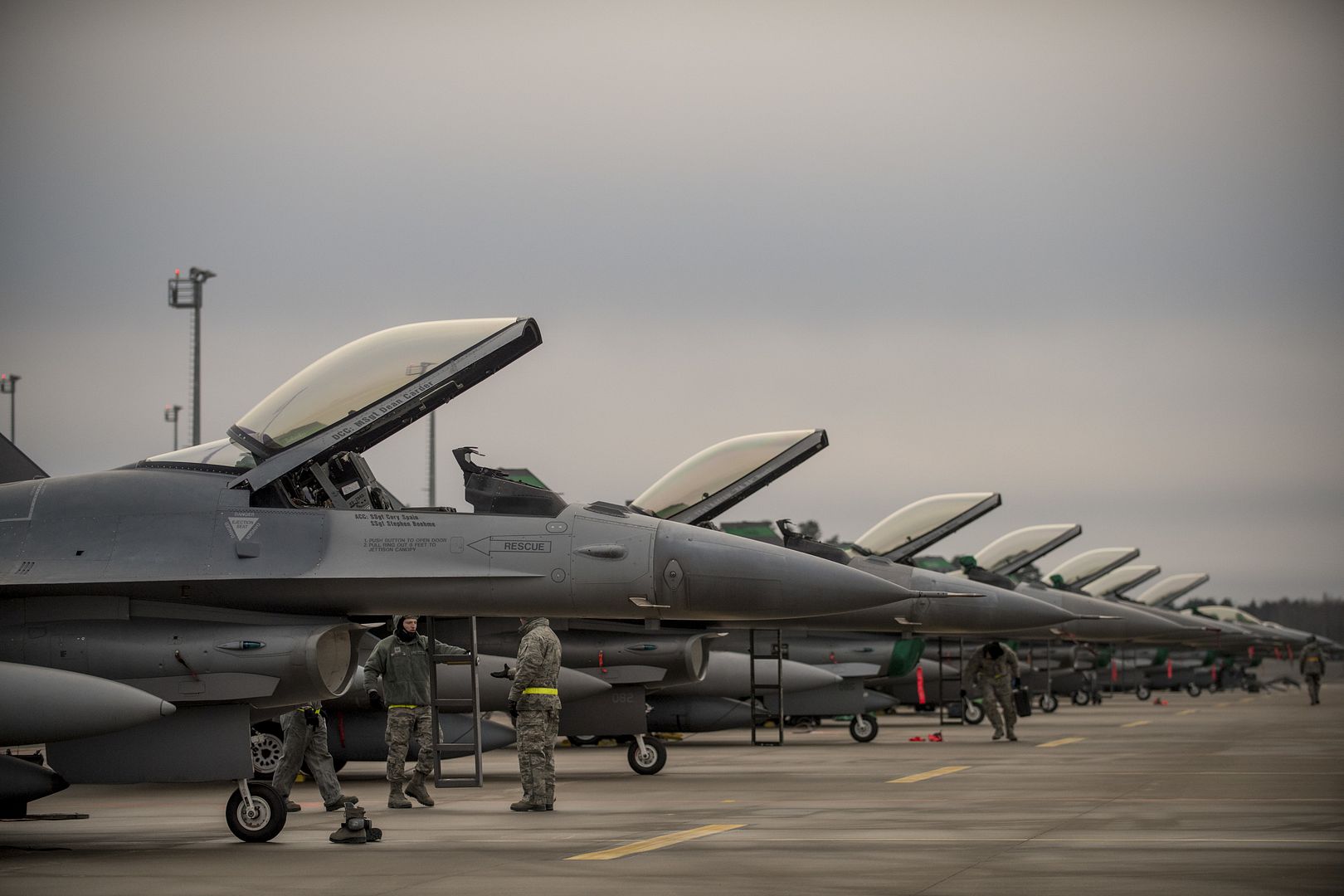
KC-135 Stratotankers assigned to the 121st Air Refueling Wing sit on the snowy flight line January 15, 2018, at Rickenbacker Air National Guard Base, Ohio. (U.S. Air National Guard photo's by Senior Master Sgt. Ralph Branson)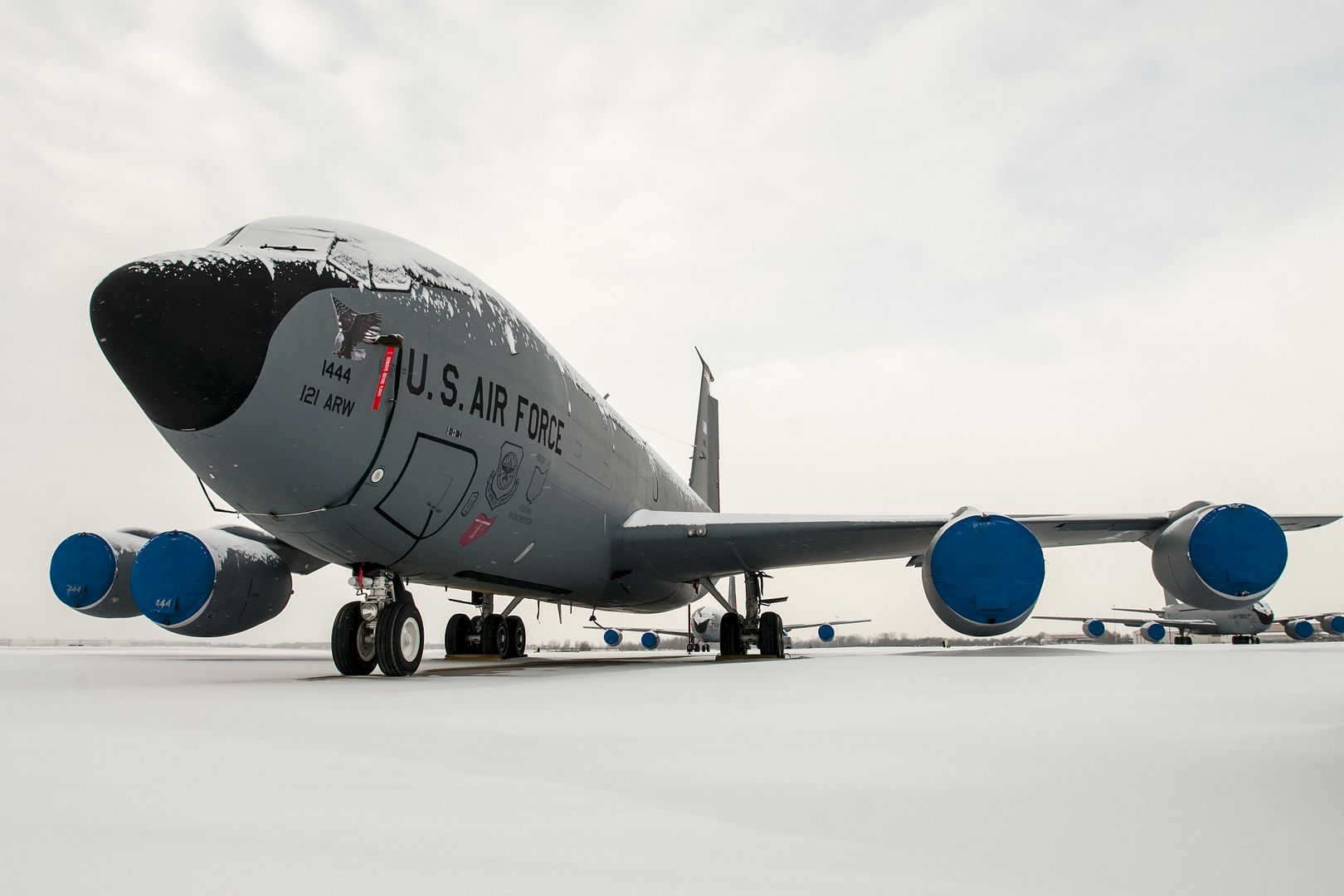
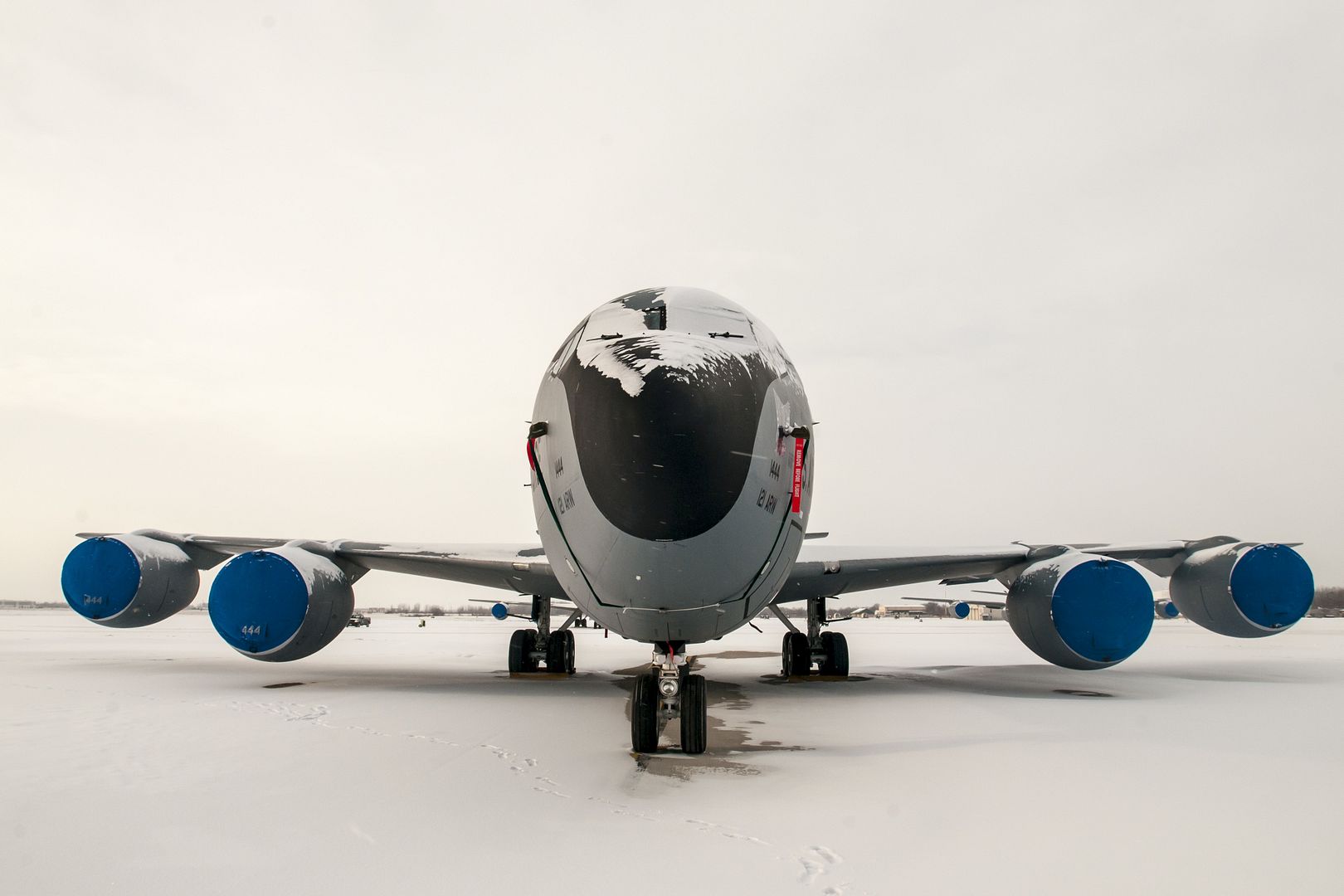
-
 Main AdminA U.S. Air Force B-52 Stratofortress bomber lands at Andersen Air Force Base, Guam,Jan. 16, 2018. The Stratofortress is one of six U.S. Air Force B-52H Stratofortress bombers and approximately 300 Airmen from Barksdale Air Force Base (AFB), Louisiana, deploying to Andersen AFB, Guam, in support of U.S. Pacific Command?s (PACOM) Continuous Bomber Presence (CBP) mission. (U.S. Air Force photo's/Tech. Sgt. Richard P. Ebensberger)
Main AdminA U.S. Air Force B-52 Stratofortress bomber lands at Andersen Air Force Base, Guam,Jan. 16, 2018. The Stratofortress is one of six U.S. Air Force B-52H Stratofortress bombers and approximately 300 Airmen from Barksdale Air Force Base (AFB), Louisiana, deploying to Andersen AFB, Guam, in support of U.S. Pacific Command?s (PACOM) Continuous Bomber Presence (CBP) mission. (U.S. Air Force photo's/Tech. Sgt. Richard P. Ebensberger)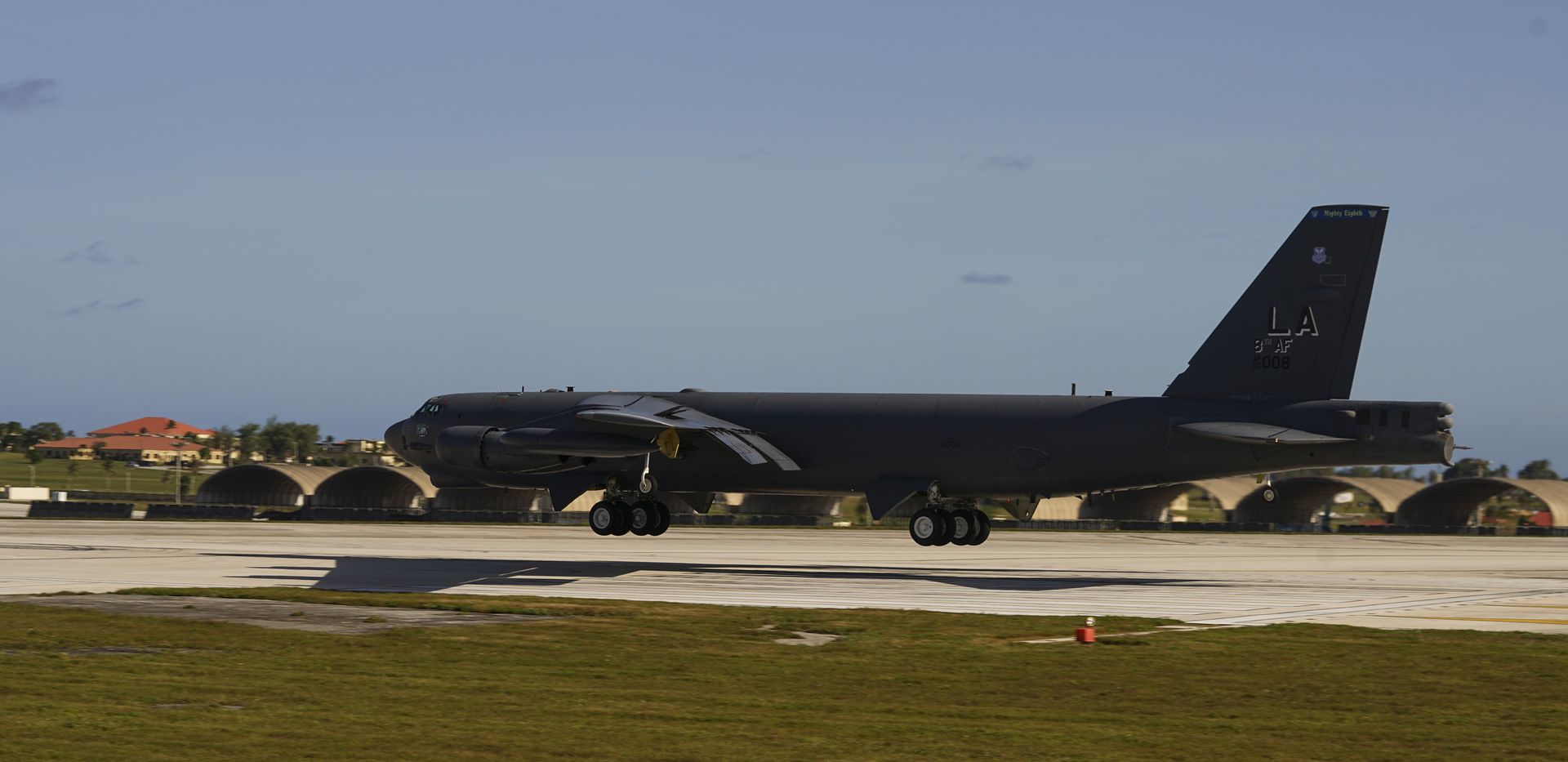

A U.S. Air Force B-52H Stratofortress bomber taxis after landing at at Andersen Air Force Base (AFB), Guam, Jan. 16, 2018. The Stratofortress is one of six U.S. Air Force B-52H Stratofortress bombers and approximately 300 Airmen from Barksdale AFB, Louisiana, deploying to Andersen AFB, in support of U.S. Pacific Command?s (PACOM) Continuous Bomber Presence (CBP) mission. (U.S. Air Force photo/Airman 1st Class Gerald R. Willis)
ATLANTIC OCEAN (Jan. 15, 2018) -- A Sailor assigned to USS Gerald R. Ford's (CVN 78) air department directs an F/A-18F Super Hornet, assigned to the "Black Lions" of Strike Fighter Squadron (VFA) 213, to a catapult onboard Ford's flight deck. Ford is underway conducting test and evaluation operations. (U.S. Navy photo by Mass Communication Specialist 3rd Class Liz Thompson)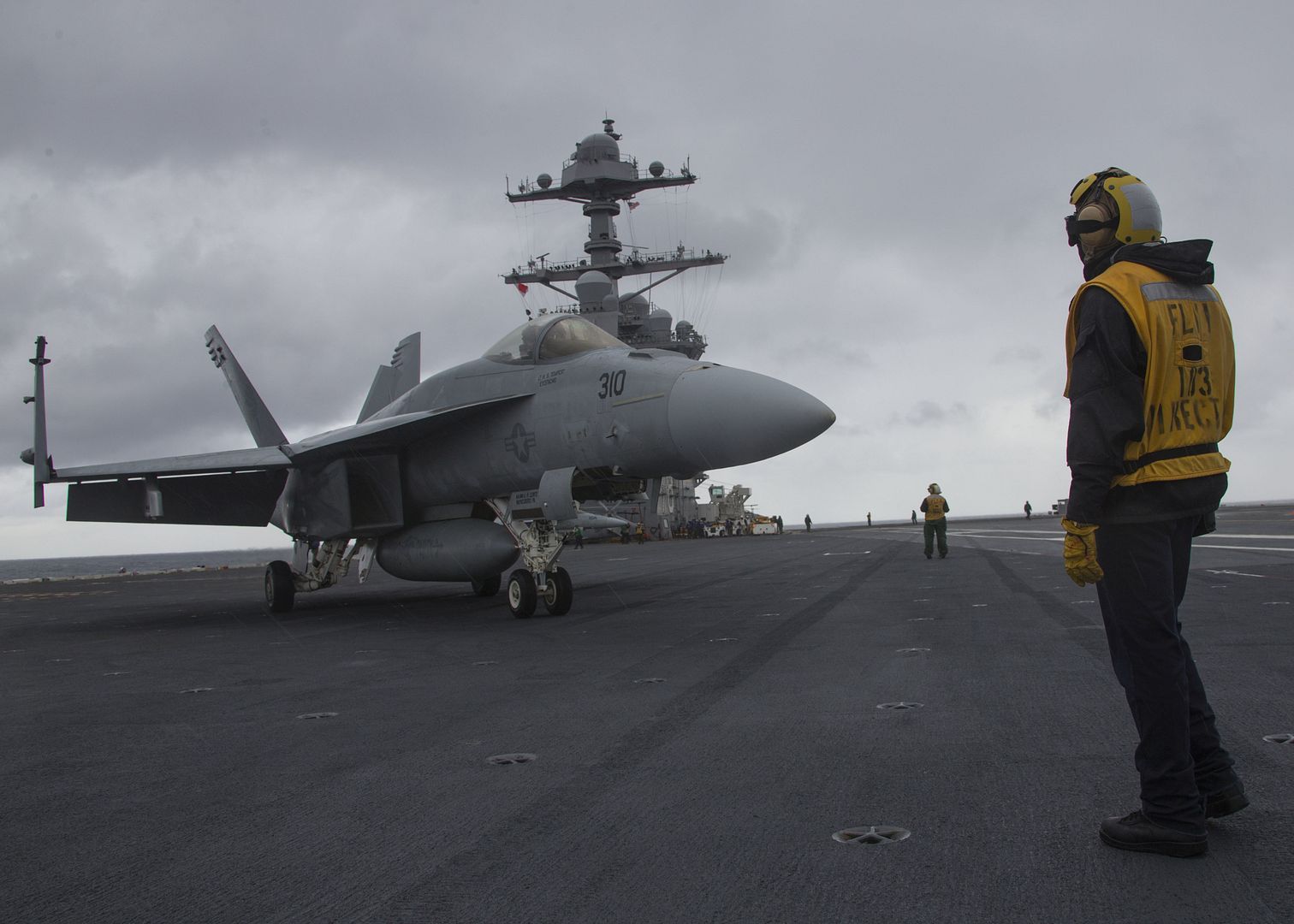
ARABIAN GULF (Jan. 15, 2018) An EA-18G Growler, assigned to the Cougars of Electronic Attack Squadron (VAQ) 139, approaches the flight deck of the aircraft carrier USS Theodore Roosevelt (CVN 71). Theodore Roosevelt and its carrier strike group are deployed to the U.S. 5th Fleet area of operations in support of maritime security operations to reassure allies and partners and preserve the freedom of navigation and the free flow of commerce in the region. (U.S. Navy photo by Mass Communication Specialist 3rd Class Spencer Roberts/Released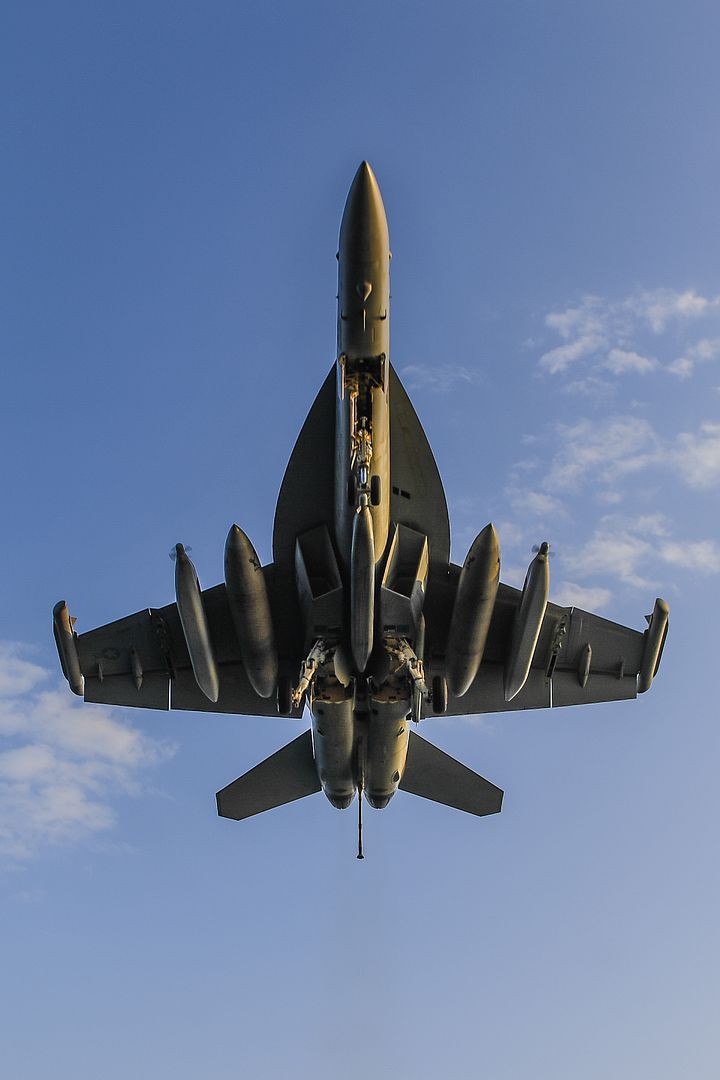
The British Army today paid special tribute as one of its most ubiquitous aviation assets bows out of service.
The Lynx helicopter has had a long and distinguished career with the British Army stretching back nearly 40 years. Described as a primary battlefield utility helicopter, the venerable Lynx entered service back in 1978 and since then has been used to: destroy tanks, evacuate the wounded, gather intelligence, provide humanitarian support, rescue those in peril, wow the crowds at airshows and much more besides. It?s seen service across the globe from the freezing plains of Northern Canada to the dust bowls of the Middle East and has supported British troops on active service in Bosnia, Kuwait and Afghanistan.
However, age has finally caught up with the Lynx and although it?ll be a tough act to follow, Wildcat will replace the Lynx. With its superior avionics uprated engines and improved capability it too will prove a formidable force over any battlefield of the future.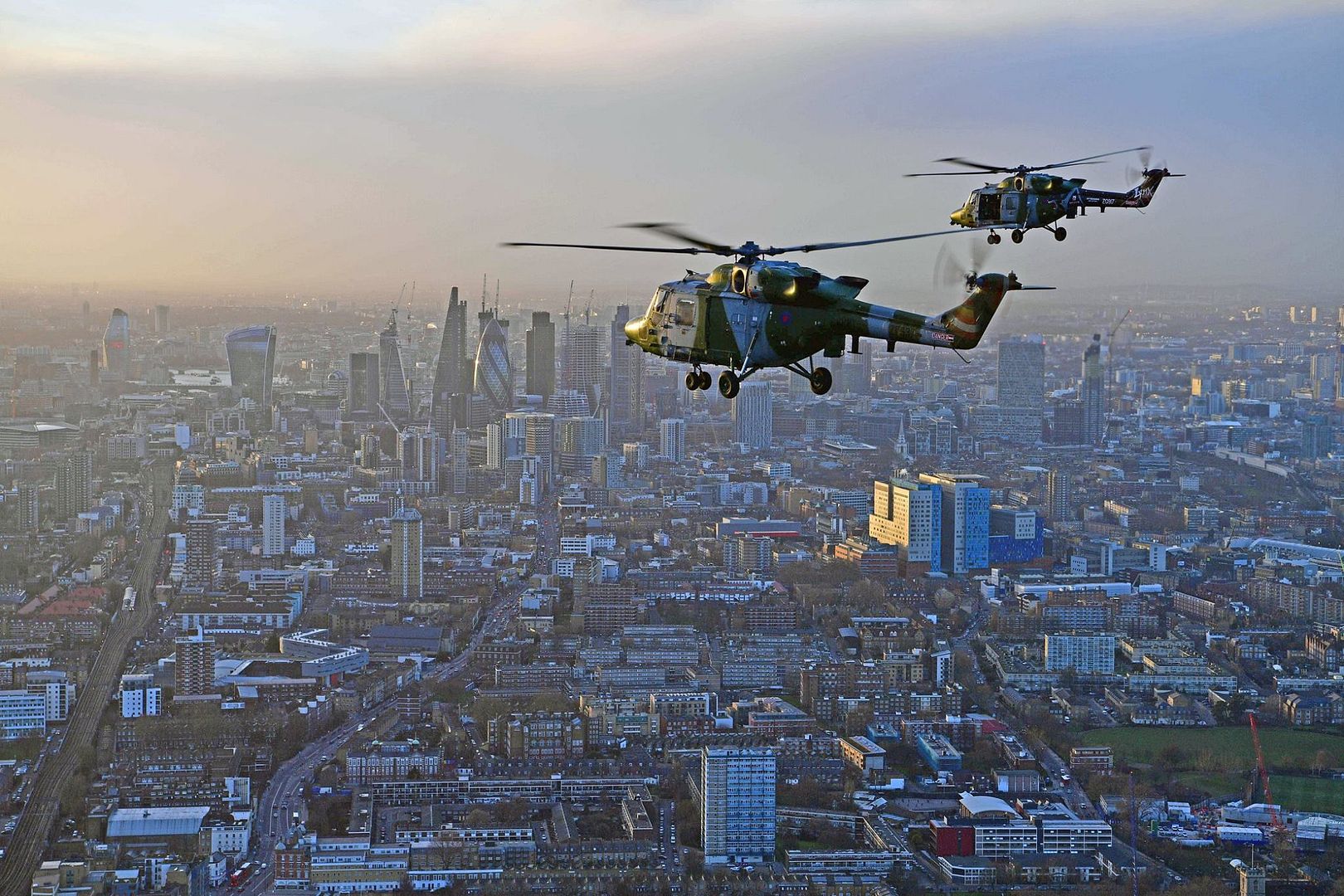
To mark the Lynx?s decommissioning from British Army service, the Army Air Corps flew five of the last remaining airframes from RAF Odiham in Hampshire, where they are based, on a commemorative tour around England taking in some of the sites and locations to which the aircraft is most fondly associated: Middle Wallop, Upavon, Yeovil, Wattisham to name a few. The flight culminated in an impressive V5 ?air procession? along the length of the River Thames over Central London.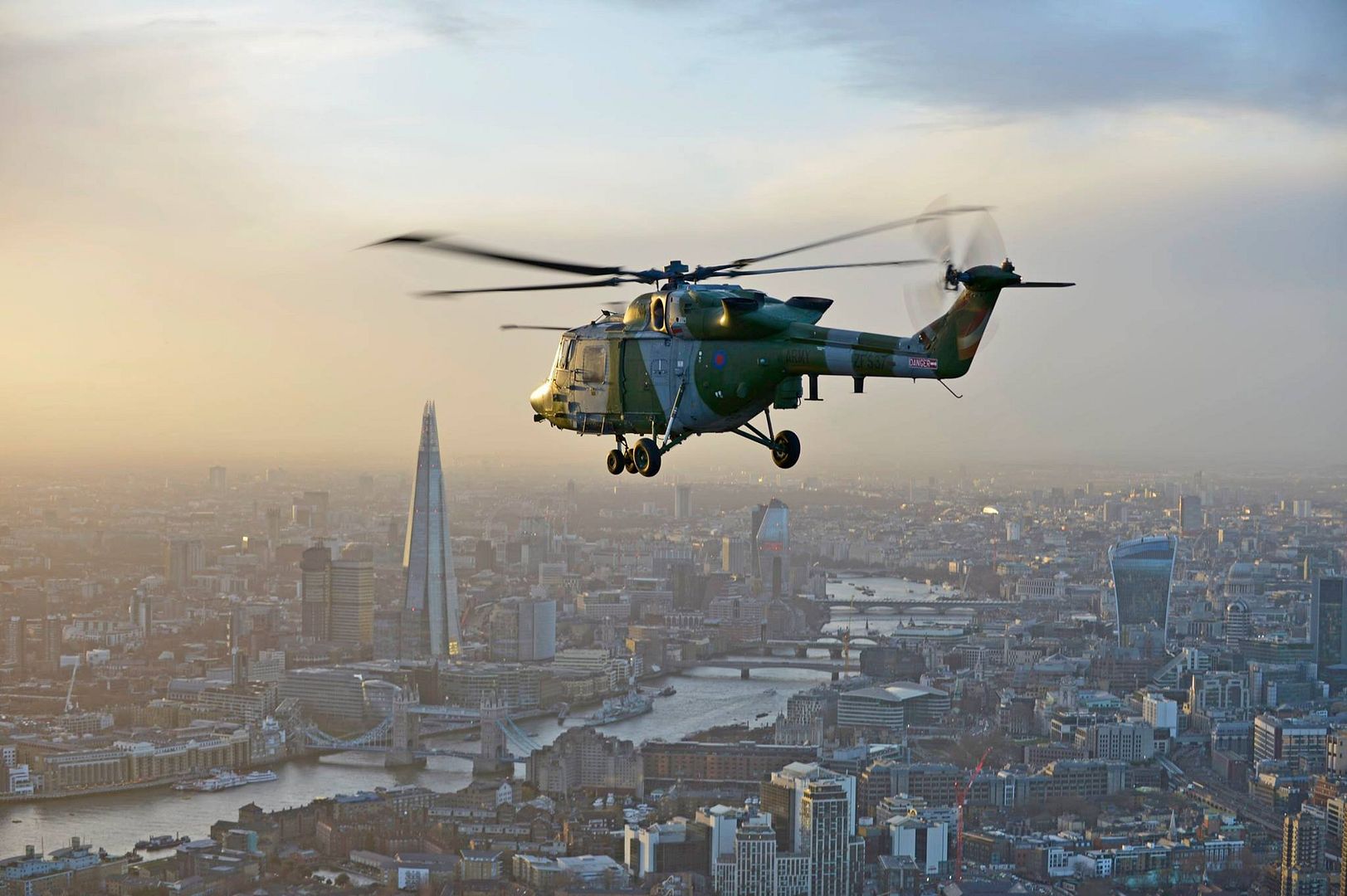
-
 Main AdminAirmen operate a deicing truck to remove ice and snow from the C-130H Hercules during bitter cold temperatures Jan. 16, 2018, at the 179th Airlift Wing, Mansfield, Ohio. The 179th Airlift Wing maintenance group regularly inspects all aspects of their aircraft to maintain mission readiness with ready airmen and ready aircraft. (U.S. Air National Guard photo's by Tech. Sgt. Joe Harwood\Released)
Main AdminAirmen operate a deicing truck to remove ice and snow from the C-130H Hercules during bitter cold temperatures Jan. 16, 2018, at the 179th Airlift Wing, Mansfield, Ohio. The 179th Airlift Wing maintenance group regularly inspects all aspects of their aircraft to maintain mission readiness with ready airmen and ready aircraft. (U.S. Air National Guard photo's by Tech. Sgt. Joe Harwood\Released)
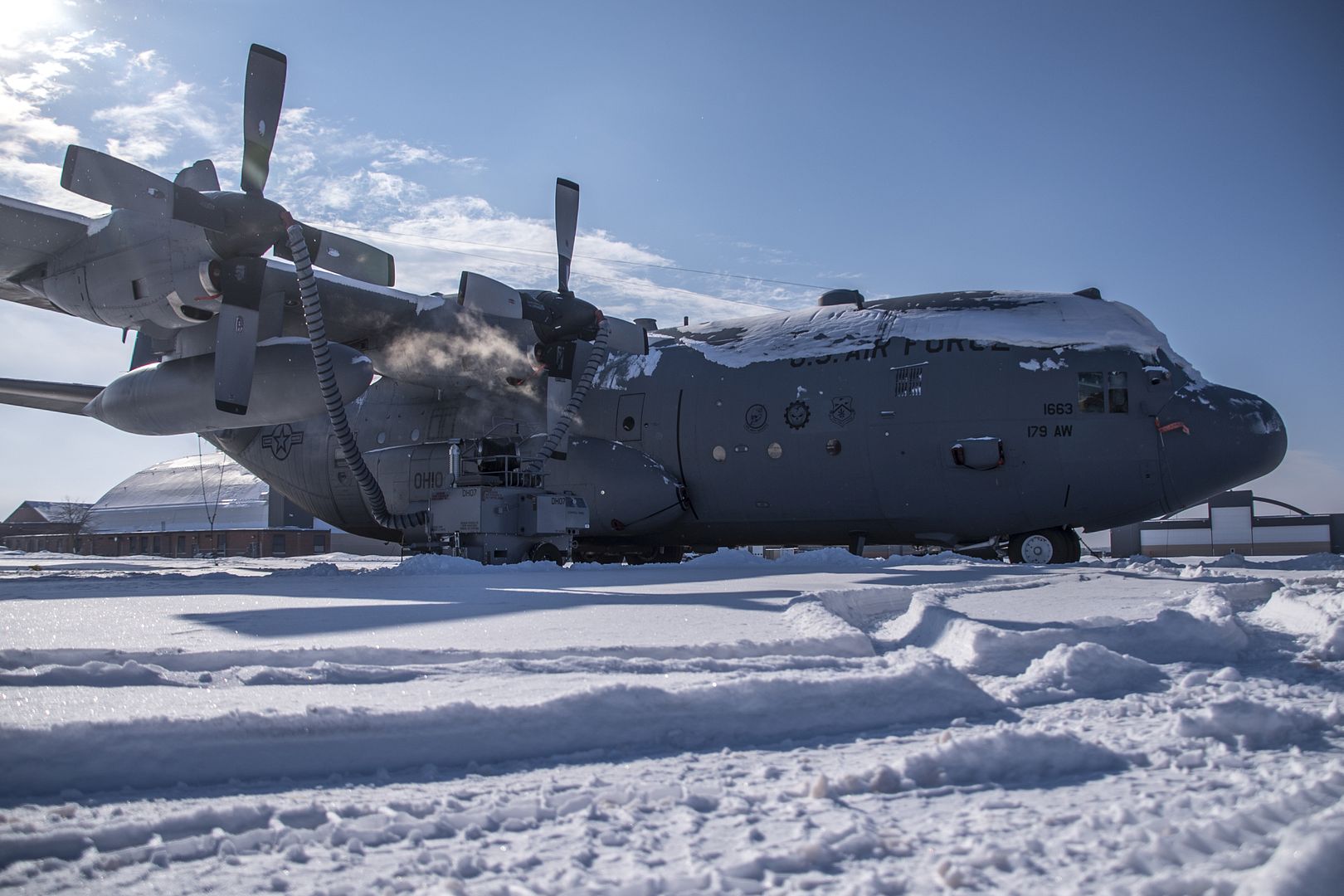
A crew chief with the 144th Fighter Wing, California Air National Guard prepare to launch a F-15 Eagle at Joint Base Pearl Harbor-Hickam on Jan. 16, 2018 as part of Sentry Aloha exercises. Sentry Aloha is an ongoing series of exercises, hosted by the Hawaii Air National Guard's 154th Wing, involving multiple types of aircraft and services. (U.S. Air National Guard photo by Staff Sgt. James Ro)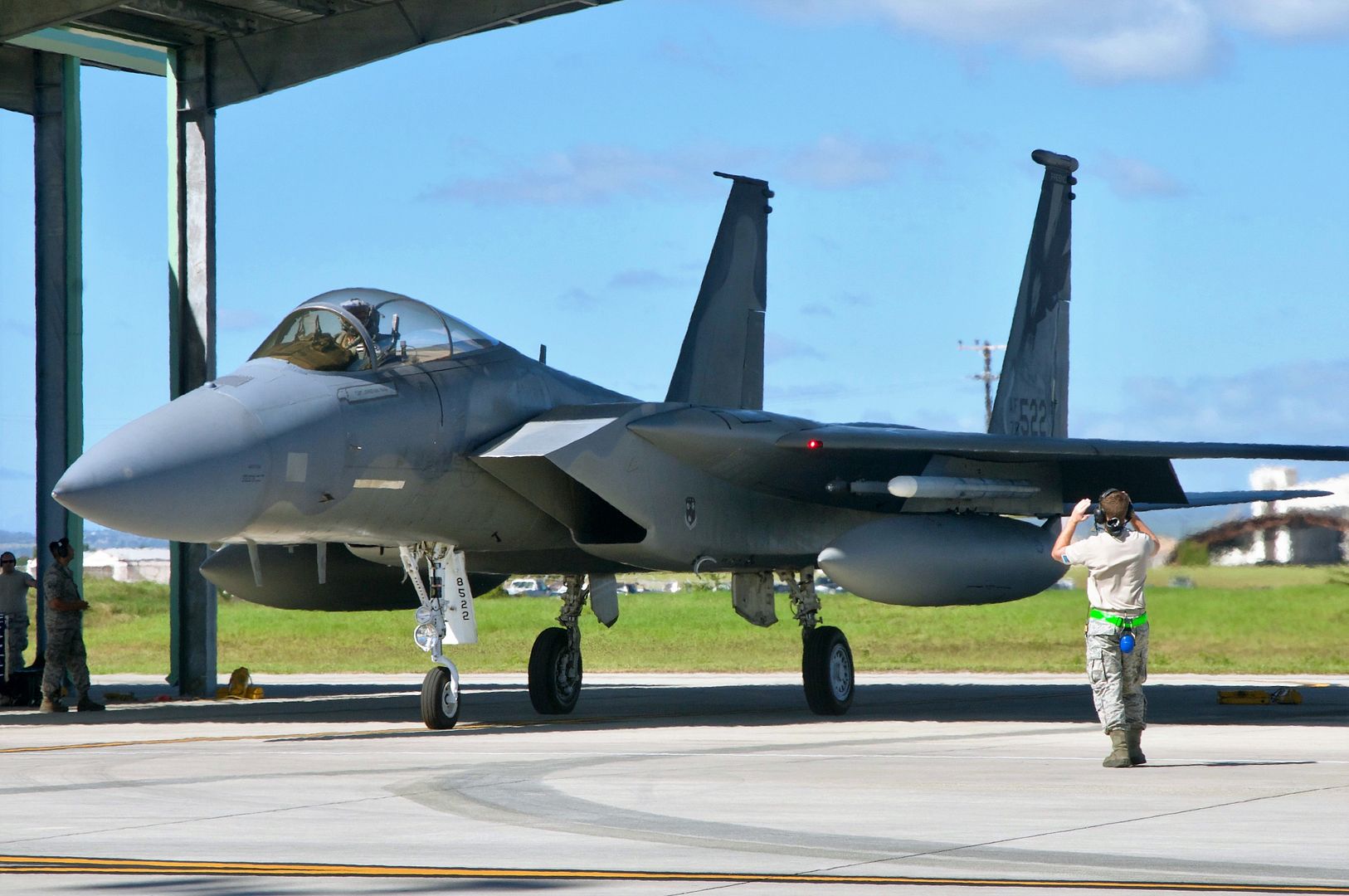
A AH-64D Apache Longbow helicopter from Bravo Company, 1st Battalion, 3rd Aviation Regiment (Attack Reconnaissance), sit inside an aircraft maintenance hangar during repairs on Jan. 16, 2018, at Katterbach Army Airfield in Ansbach, Bavaria, Germany. (U.S. Army photo by Charles Rosemond)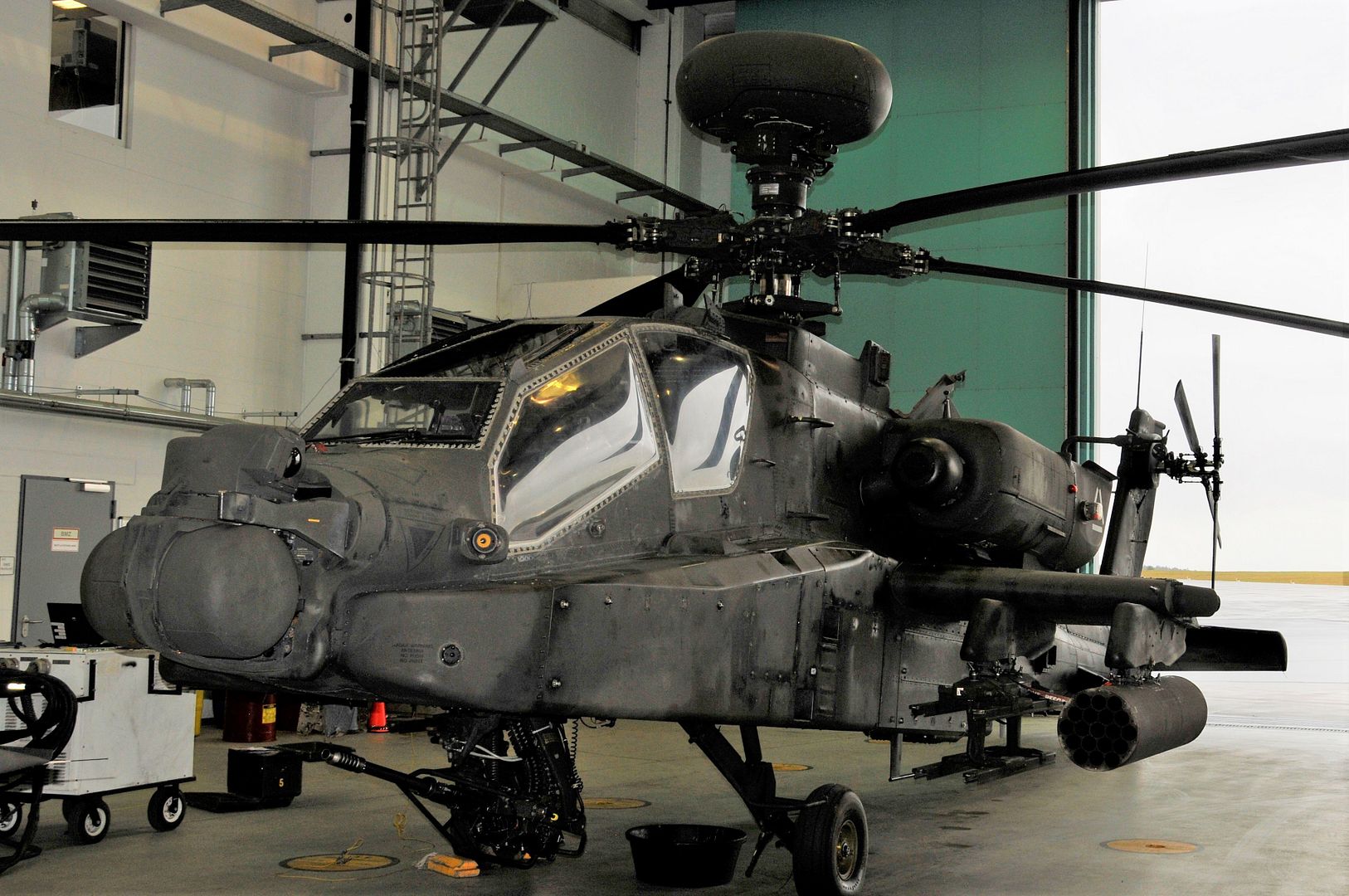
PACIFIC OCEAN (Jan. 16, 2018) An F/A-18E Super Hornet assigned to the Golden Dragons of Strike Fighter Squadron (VFA) 192 prepares to land on the flight deck of the Nimitz-class aircraft carrier USS Carl Vinson (CVN 70). The Carl Vinson Strike Group is currently operating in the Pacific as part of a regularly scheduled deployment. (U.S. Navy photo by Mass Communication Specialist 3rd Class Dylan M. Kinee/Released)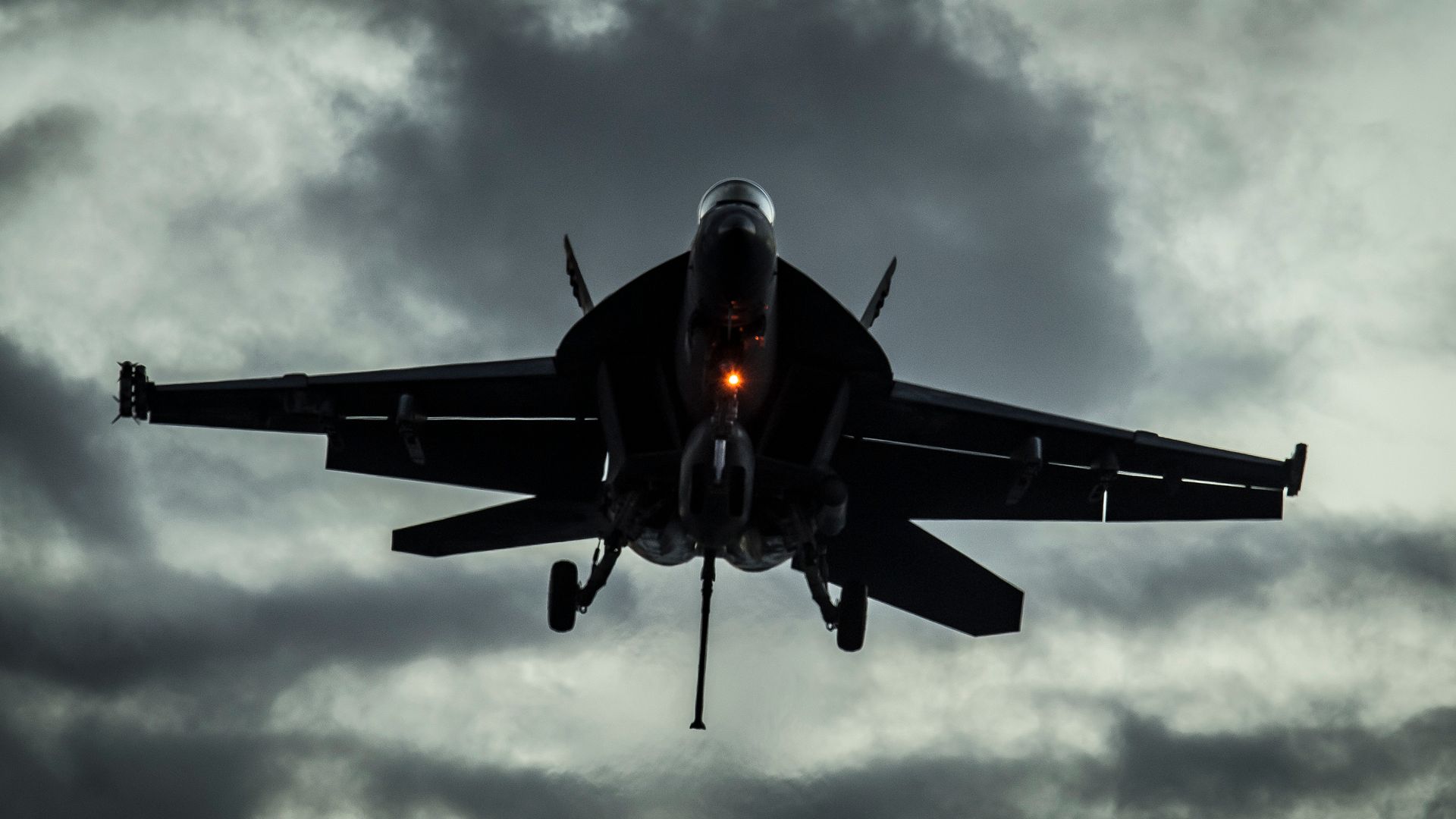
PACIFIC OCEAN (Jan. 16, 2018) An EA-18G Growler from the Gauntlets of Electronic Attack Squadron (VAQ) 136 takes off from the Nimitz-class aircraft carrier USS Carl Vinson (CVN 70) flight deck. The Carl Vinson Strike Group is currently operating in the Pacific as part of a regularly scheduled deployment. (U.S. Navy photo by Mass Communication Specialist 3rd Class Jasen Morenogarcia/Released)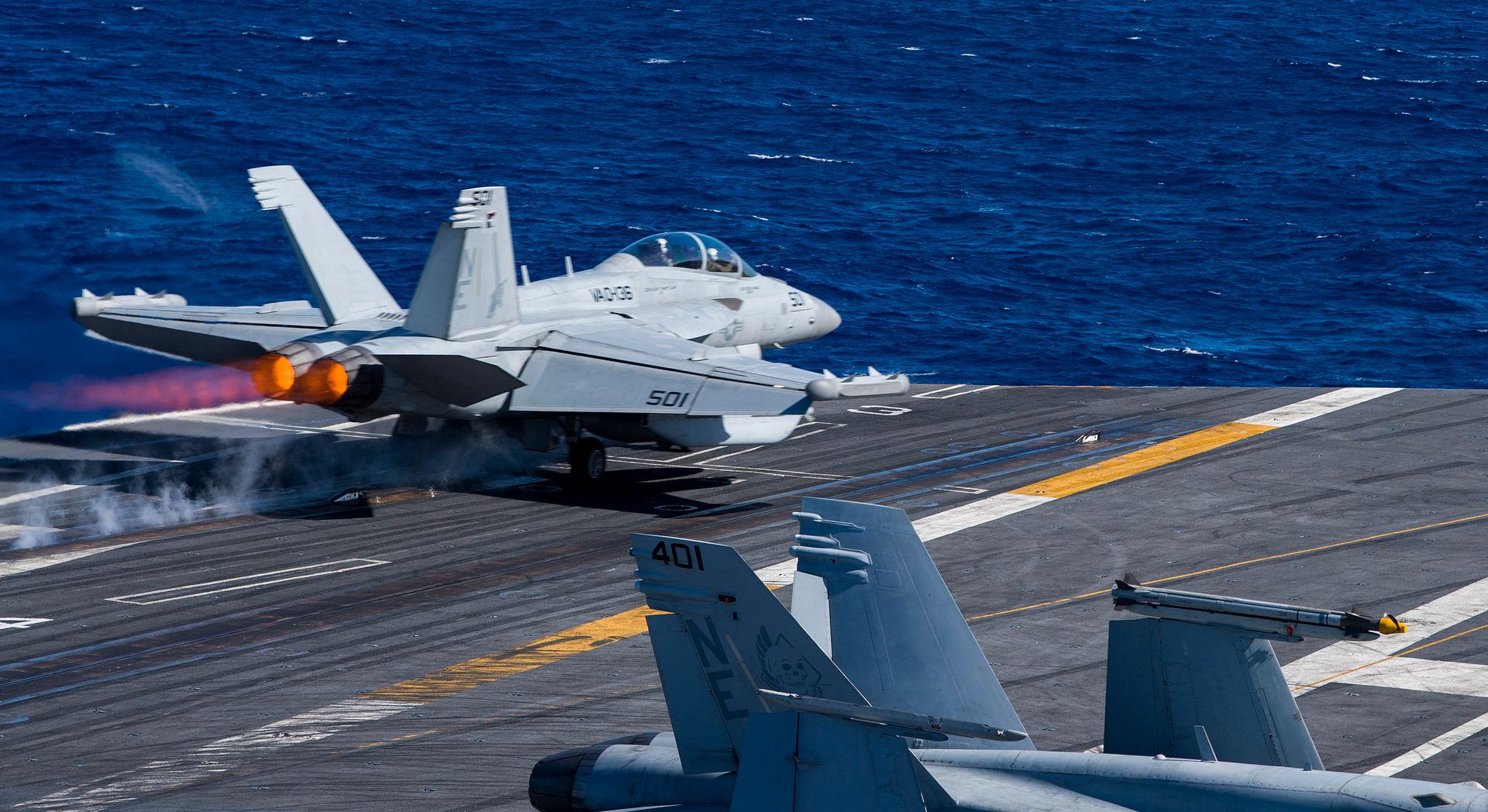
-
 Main Admin?Black Cat? CH-47 Chinook helicopter crews of Company B, 2nd General Support Aviation Battalion, 227th Aviation Regiment, 1st Combat Aviation Brigade, 1st Cavalry Division, conduct flights inside the Hohenfels Training Area in Germany, Jan. 16, 2018. The crews are familiarizing themselves with the training area in preparation for their role in Allied Spirit VIII, an exercise to enhance NATO and key partner interoperability, build readiness and strengthen relationships. (U.S. Army photo by Sgt. Gregory T. Summers / 22nd Mobile Public Affairs Detachment)
Main Admin?Black Cat? CH-47 Chinook helicopter crews of Company B, 2nd General Support Aviation Battalion, 227th Aviation Regiment, 1st Combat Aviation Brigade, 1st Cavalry Division, conduct flights inside the Hohenfels Training Area in Germany, Jan. 16, 2018. The crews are familiarizing themselves with the training area in preparation for their role in Allied Spirit VIII, an exercise to enhance NATO and key partner interoperability, build readiness and strengthen relationships. (U.S. Army photo by Sgt. Gregory T. Summers / 22nd Mobile Public Affairs Detachment)
SBIRS GEO Flight 4 payload mated with its Atlas V-411 rocket completed a roll out at SPacee Launch Complex-41, Cape Canaveral Air Force base, 17 Jan, 2018.
Photo's by Van Ha.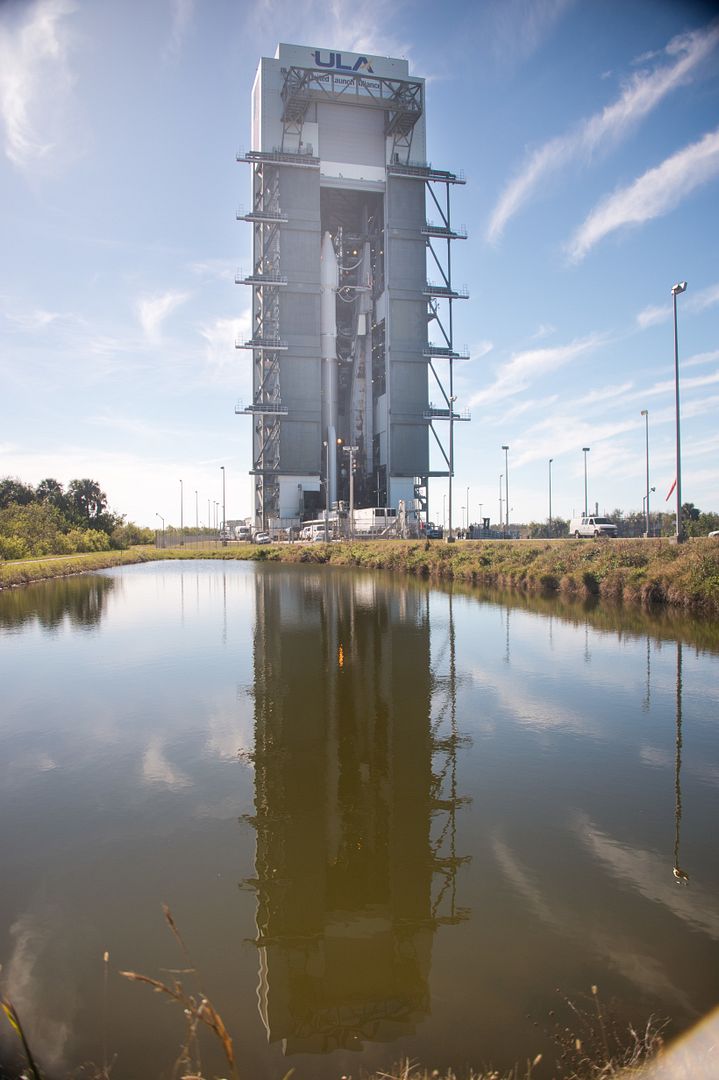
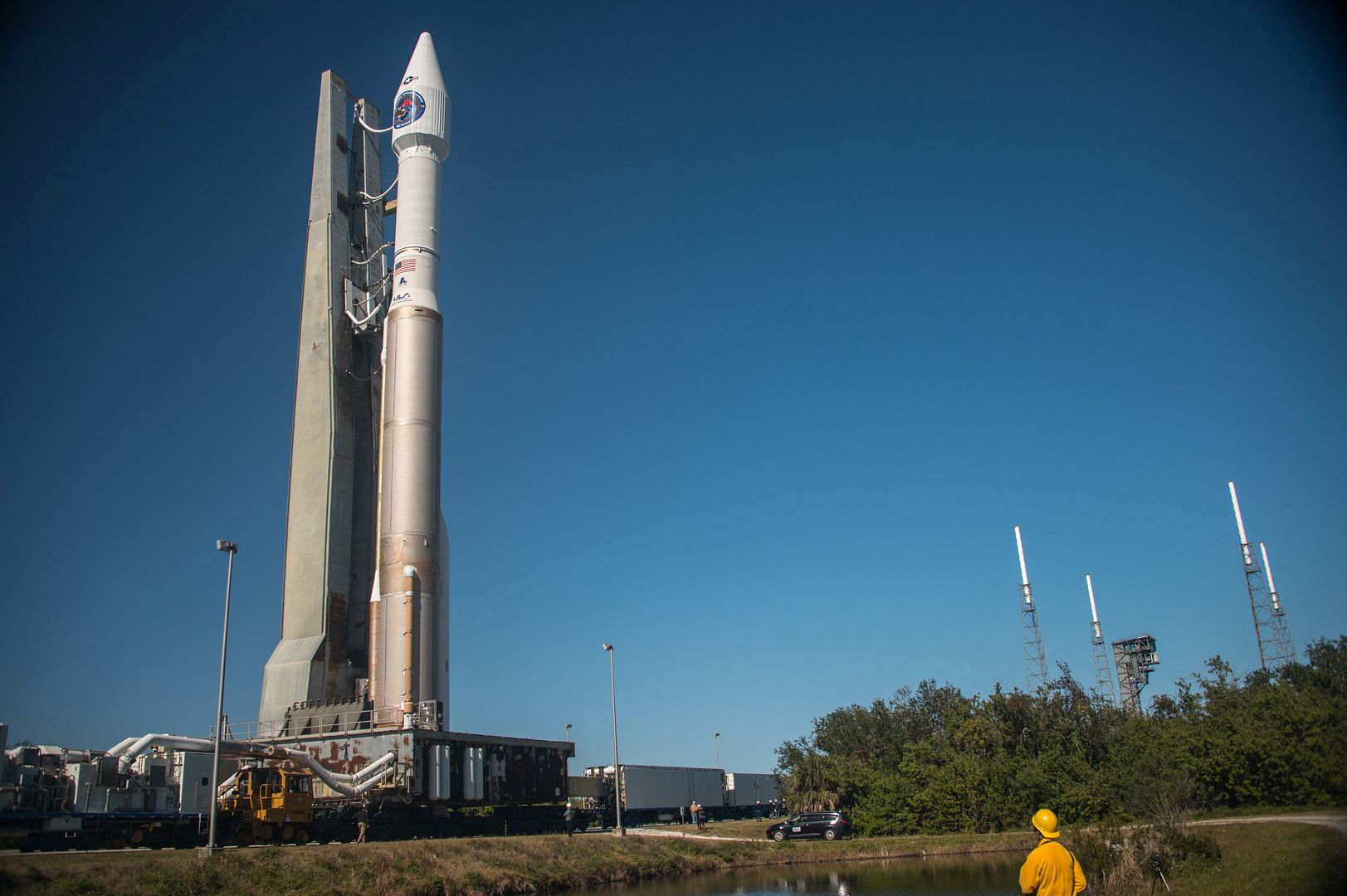
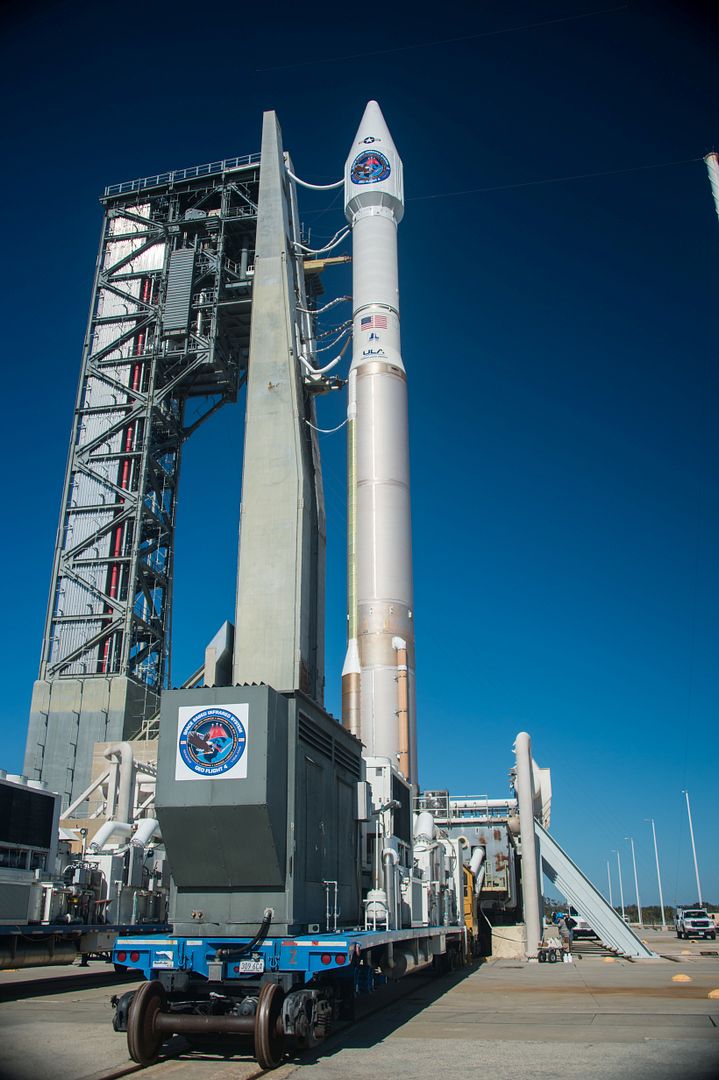
A U.S. Marine Corps AV-8B Harrier pilot takes off from the runway Jan. 18, 2018 at the 180th Fighter Wing in Swanton, Ohio for a joint air-to-air combat training mission between the 180FW and 231st Marine Attack Squadron. The cold-weather environment allowed the pilots and support personal to train in an environment outside their normal experience, providing valuable insight into how the cold weather impacts the aircraft. (U.S. Air National Guard photo's by Staff Sgt. Shane Hughes)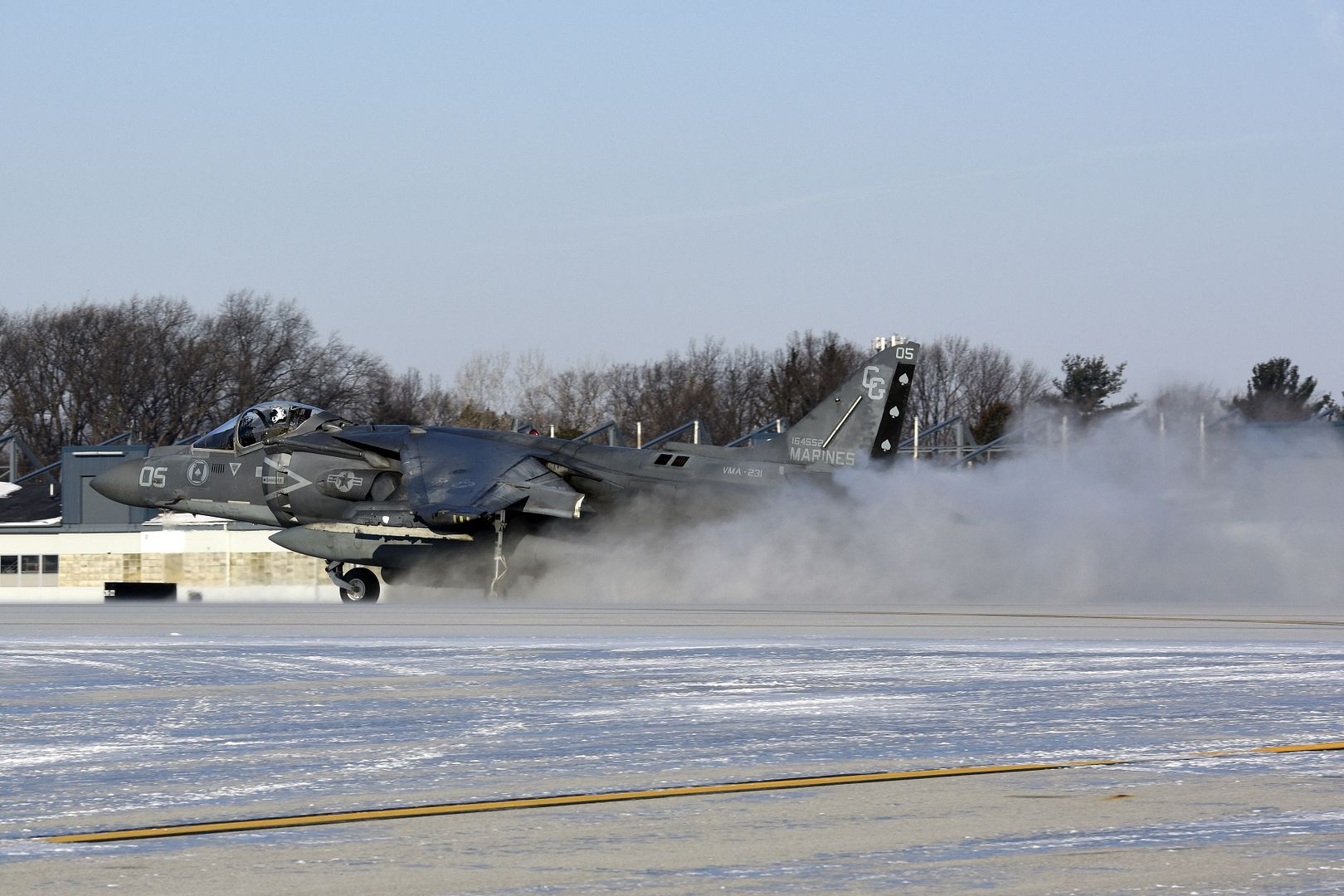
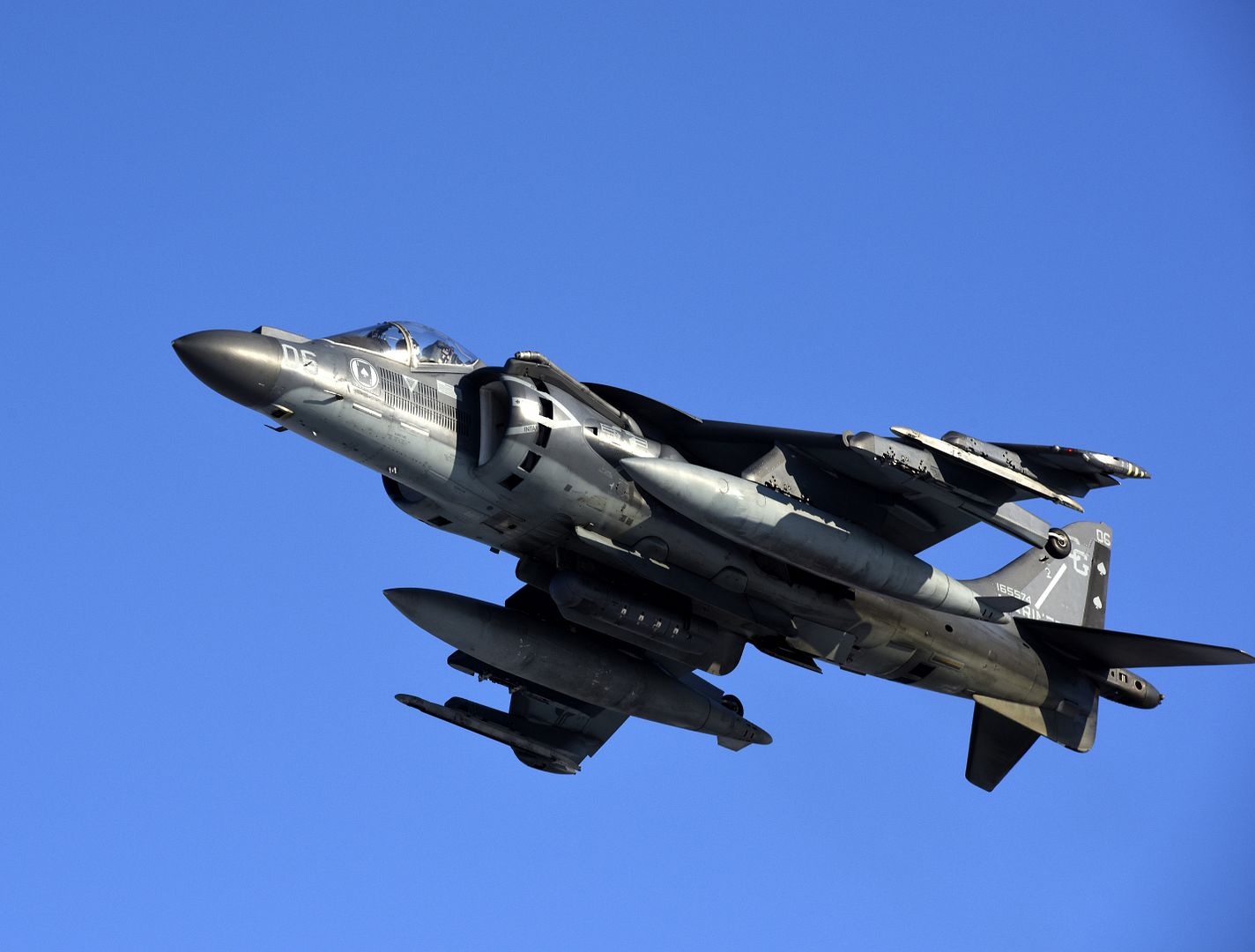
A U.S. Air Force F-15 Eagle from California Air National Guard?s 144th Fighter Wing approaches the boom of a KC-135 Stratotanker from Iowa ANG?s 185th Air Refueling Wing during Sentry Aloha 18-01 above Joint Base Pearl Harbor-Hickam, Hawaii Jan. 17, 2018. Sentry Aloha provides tailored, cost effective and realistic combat training for U.S. Air Force, Air National Guard and other Department of Defense services to provide U.S. warfighters with the skill sets necessary to perform their homeland defense and overseas combat missions. (Air National Guard photo by Senior Master Sgt. Chris Drudge)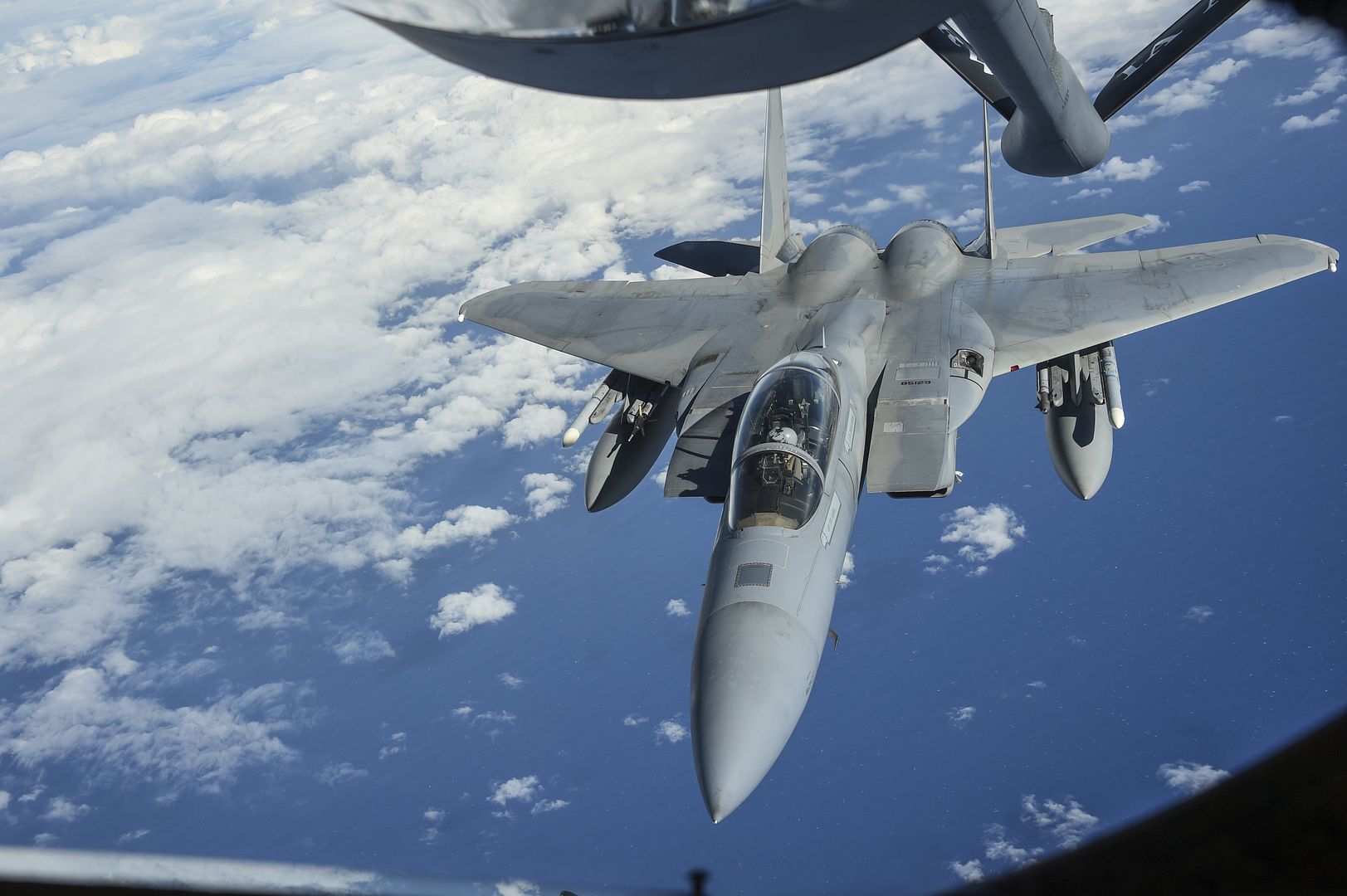
A B-52 Stratofortress from the 5th Bomb Wing, Minot Air Force Base, N.D., sits on the flightline of Mor?n Air Base, Spain, Jan. 17, 2018. A total of four strategic bombers deployed to RAF Fairford, England, to conduct theater integration and training with joint partners, allied nations and other U.S. Air Force units. (U.S. Air Force photo by Senior Airman Natalie Plas)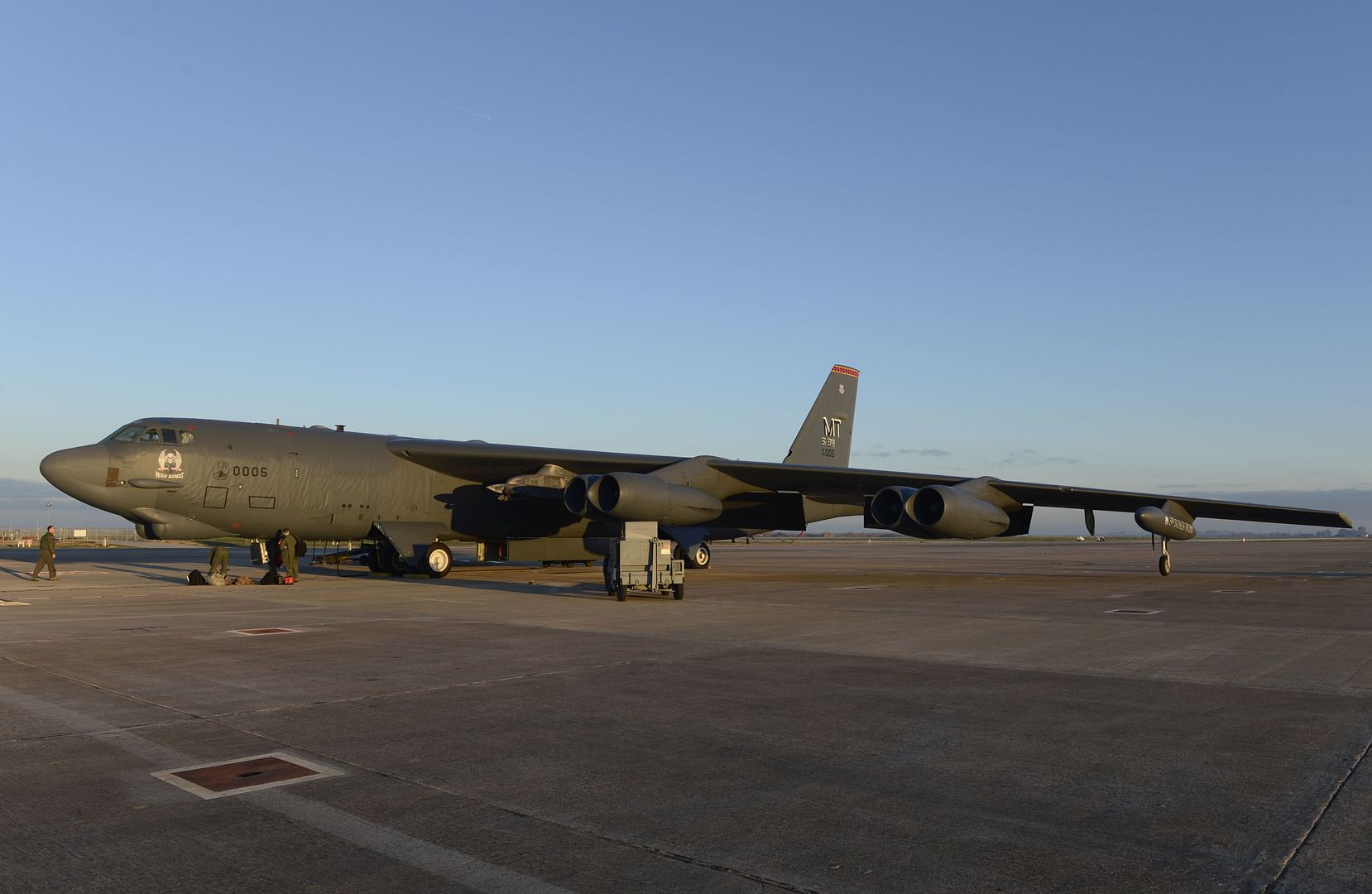
Dubai-based Emirates Airline has signed a Memorandum of Understanding (MoU) to acquire up to 36 additional A380 aircraft. The agreement was signed this morning at the airline?s headquarters in Dubai by HH Sheikh Ahmed bin Saeed Al Maktoum, Chairman and Chief Executive, Emirates Airline and Group, and John Leahy, Chief Operating Officer - Customers, Airbus Commercial Aircraft. The commitment is for 20 A380s and an option for 16 more with deliveries to start in 2020, valued at US$16 billion at latest list prices.
Sheikh Ahmed said: ?We?ve made no secret of the fact that the A380 has been a success for Emirates. Our customers love it, and we?ve been able to deploy it on different missions across our network, giving us flexibility in terms of range and passenger mix. He added: ?Some of the new A380s we?ve just ordered will be used as fleet replacements. This order will provide stability to the A380 production line. We will continue to work closely with Airbus to further enhance the aircraft and onboard product, so as to offer our passengers the best possible experience. The beauty of this aircraft is that the technology and real estate on board gives us plenty of room to do something different with the interiors.?
"I would like to thank Emirates, HH Sheikh Ahmed, Tim Clark and Adel Al-Redha for their continued support of the A380,? said John Leahy, Chief Operating Officer - Customers, Airbus Commercial Aircraft. ?This aircraft has contributed enormously to Emirates' growth and success since 2008 and we are delighted that it will continue to do so. This new order underscores Airbus? commitment to produce the A380 at least for another 10 years. I?m personally convinced more orders will follow Emirates? example and that this great aircraft will be built well into the 2030s.?
Following delivery of its first A380 in July 2008, Emirates took its 100th A380 on the 3rd November 2017 in Hamburg, Germany.
The A380 is an essential part of the solution to sustainable growth, alleviating traffic congestion at busy airports by transporting more passengers with fewer flights. The A380 is the best way to capture growing world air traffic, which doubles every 15 years. The A380 flies 8,200 nautical miles (15,200 kilometres) non-stop and can accommodate 575 passengers in four classes.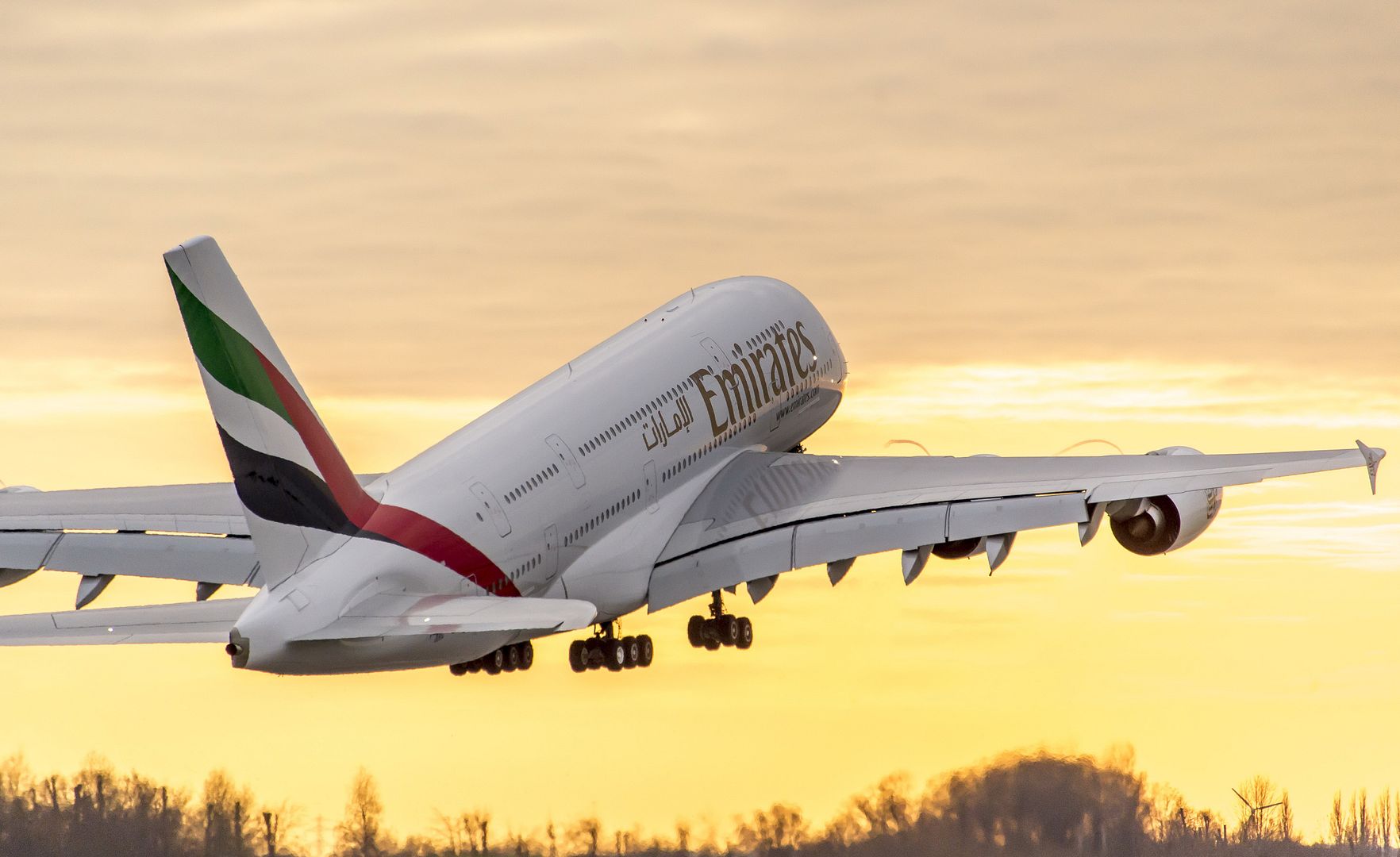
The spacious, quiet cabin, smooth and most comfortable ride have made the A380 today?s passenger favourite, resulting in higher load factors wherever it flies. The A380 is the world?s largest passenger aircraft, with two full widebody decks, offering the widest seats, wide aisles and more floor space. The A380 has the unique capability to generate revenue, stimulate traffic and attract passengers, who can now specifically select the A380 when booking a flight via the innovative iflyA380.com website.
To date, over 200 million passengers have already enjoyed the unique experience of flying on board an A380. Every two minutes an A380 either takes off or lands at one of the 240 airports around the world, ready to accommodate this magnificent aircraft. To date, 222 A380s have been delivered to 13 airlines.
-
 Main AdminA U.S. Marine Corps AV-8B Harrier II receives fuel from a U.S. Air Force HC-130J Combat King II during a training exercise over Yuma, Ariz., Jan. 17, 2018. This was the first time this HC-130J?s crew refueled a fixed-wing aircraft. (U.S. Air Force photo's by Airman 1st Class Frankie D. Moore)
Main AdminA U.S. Marine Corps AV-8B Harrier II receives fuel from a U.S. Air Force HC-130J Combat King II during a training exercise over Yuma, Ariz., Jan. 17, 2018. This was the first time this HC-130J?s crew refueled a fixed-wing aircraft. (U.S. Air Force photo's by Airman 1st Class Frankie D. Moore)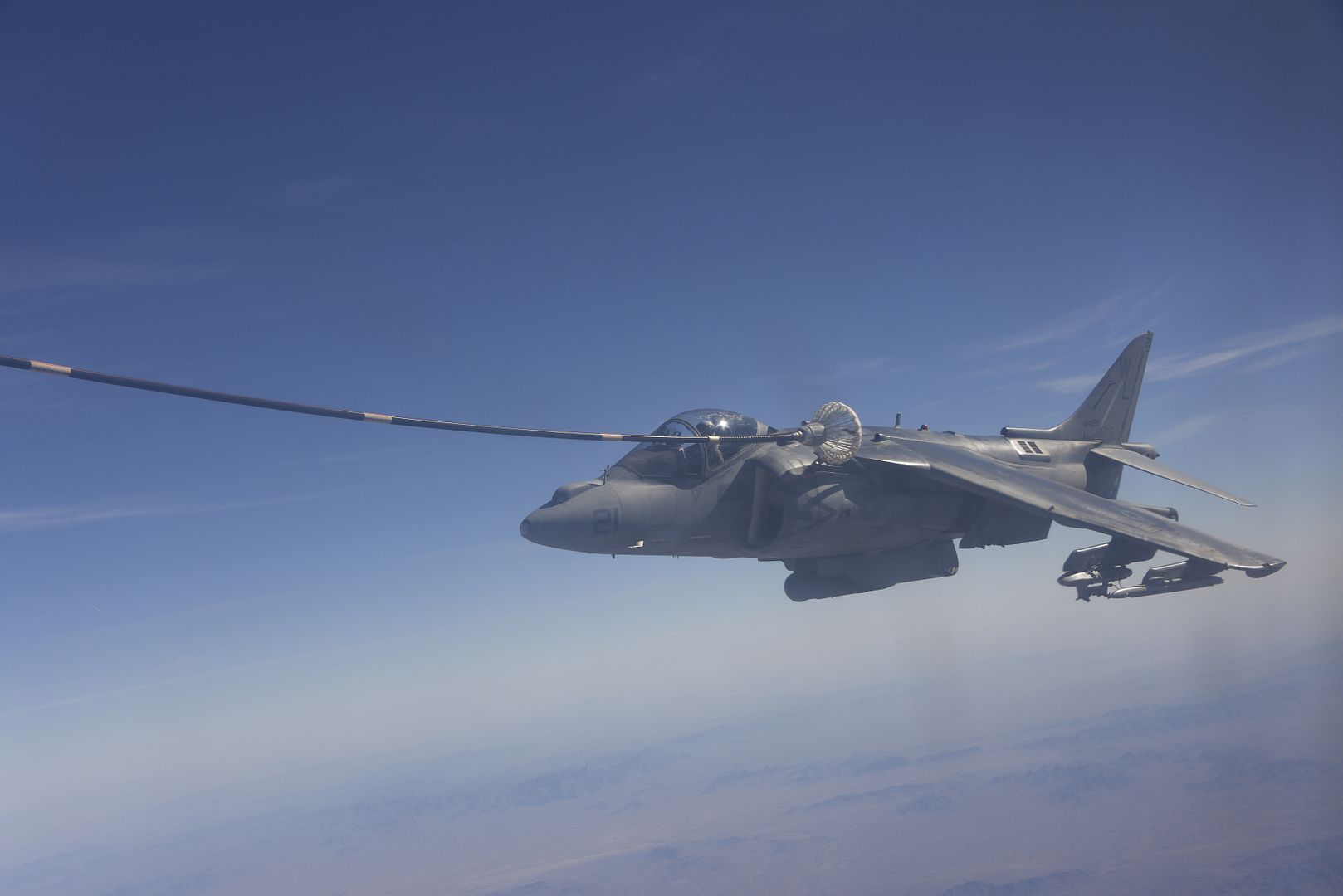

Two U.S. Marine Corps AV-8B Harrier II?s fly in formation over Yuma, Ariz., Jan. 17, 2018. The AV-8B?s conducted aerial refueling with 79th Rescue Squadron Airmen out of Davis-Monthan Air Force Base. (U.S. Air Force photo by Airman 1st Class Frankie D. Moore)
Air Force One prepares for landing at the Pennsylvania Air National Guard?s 171st Air Refueling Wing in Coraopolis, Pa. Jan. 18, 2018. (U.S. Air National Guard Photo by Senior Airman Kyle Brooks)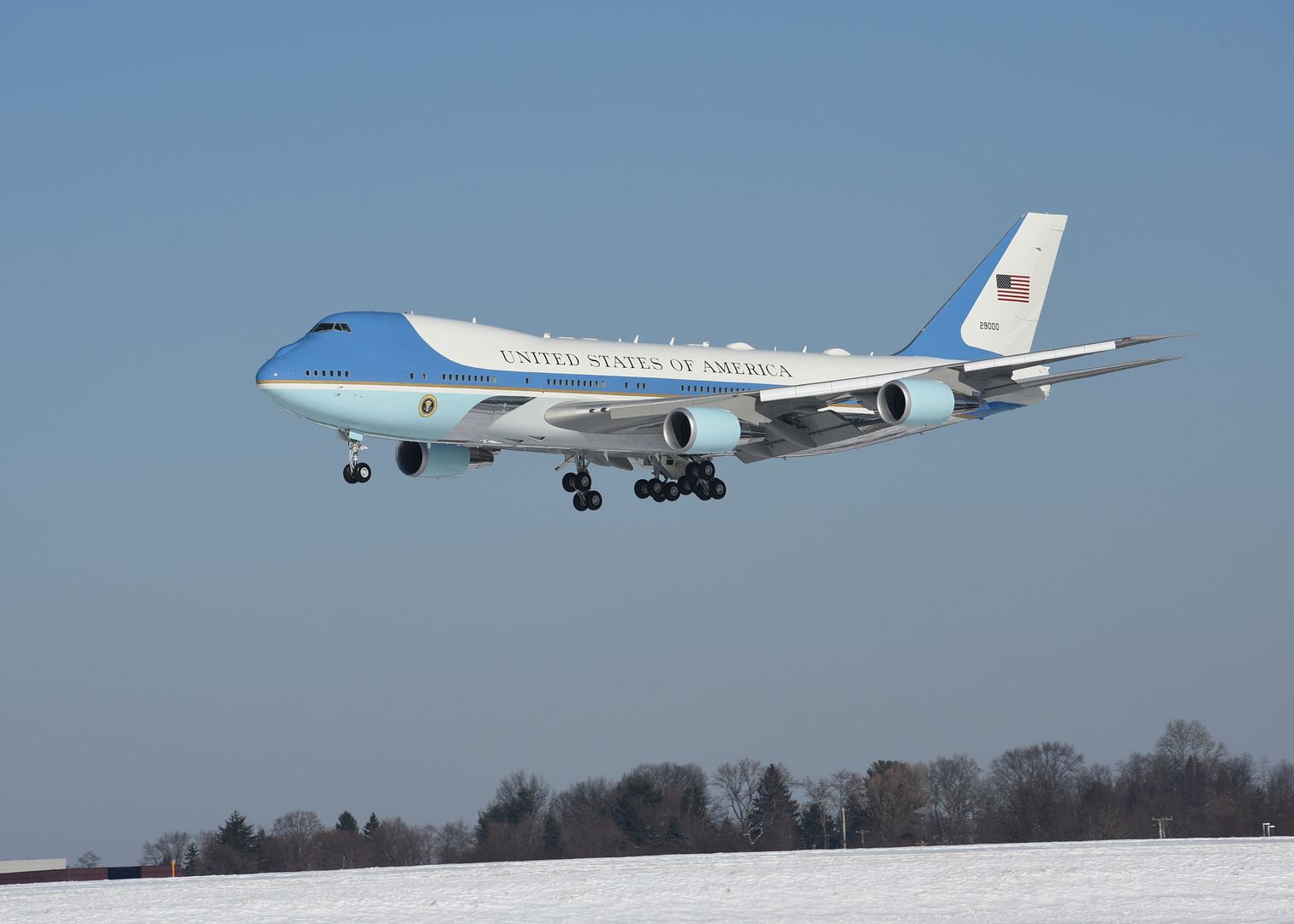
PACIFIC OCEAN (Jan. 18, 2018) An F/A-18C Hornet assigned to the "Blue Blasters" of Strike Fighter Squadron (VFA) 34 lands on the flight deck of the Nimitz-class aircraft carrier USS Carl Vinson (CVN 70). The Carl Vinson Strike Group is currently operating in the Pacific as part of a regularly scheduled deployment. (U.S. Navy Photo by Mass Communication Specialist 3rd Class Jake Cannady/Released)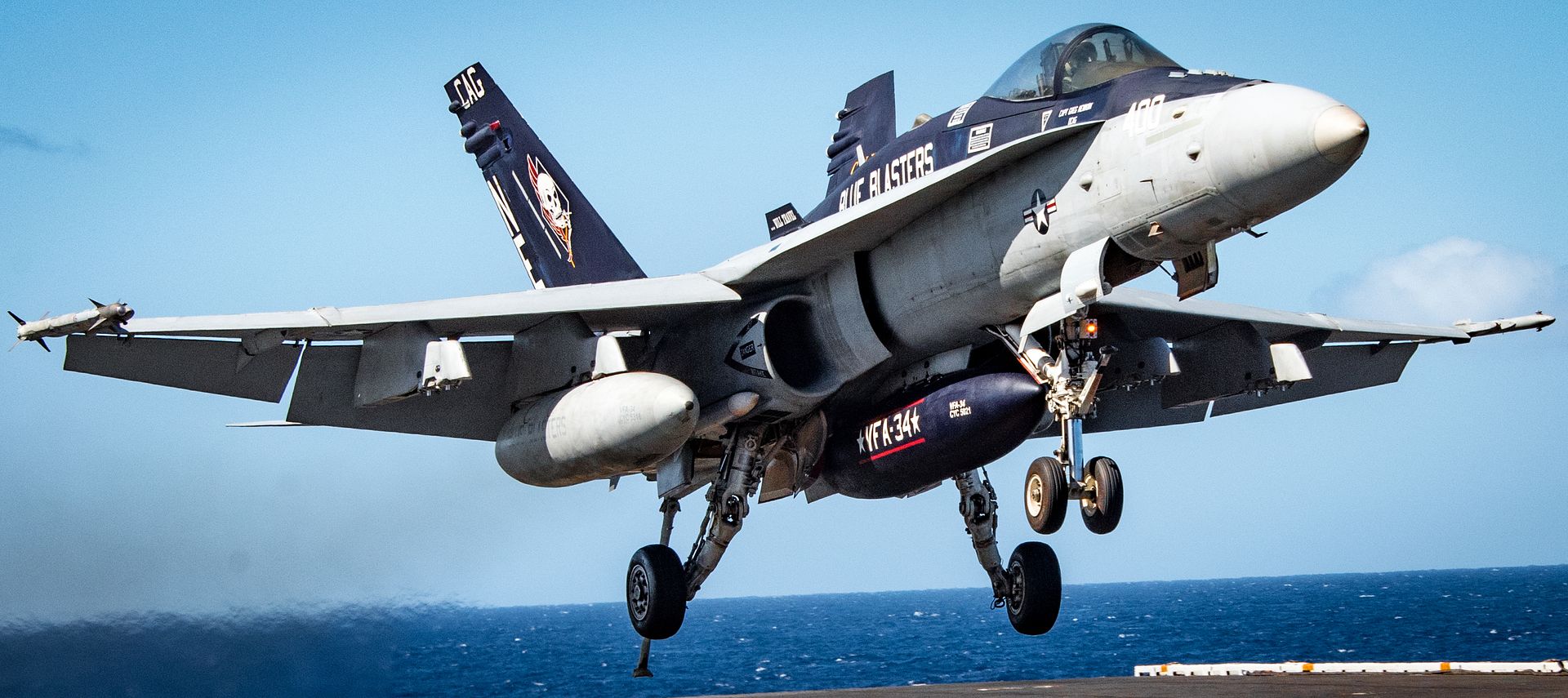
PACIFIC OCEAN (Jan. 18, 2018) Capt. Tom Barber, Commander, Carrier Air Wing 2 and Cmdr. Jason Hutcherson, commanding officer of the "Bounty Hunters" of Strike Fighter Squadron (VFA) 2 complete their 1000th carrier arrested landing or "trap" on board the Nimitz-class aircraft carrier USS Carl Vinson (CVN 70). The Carl Vinson Strike Group is currently operating in the Pacific as part of a regularly scheduled deployment (U.S. Navy photo by Mass Communication Specialist Seaman Apprentice Eleanor D. Vara/Released)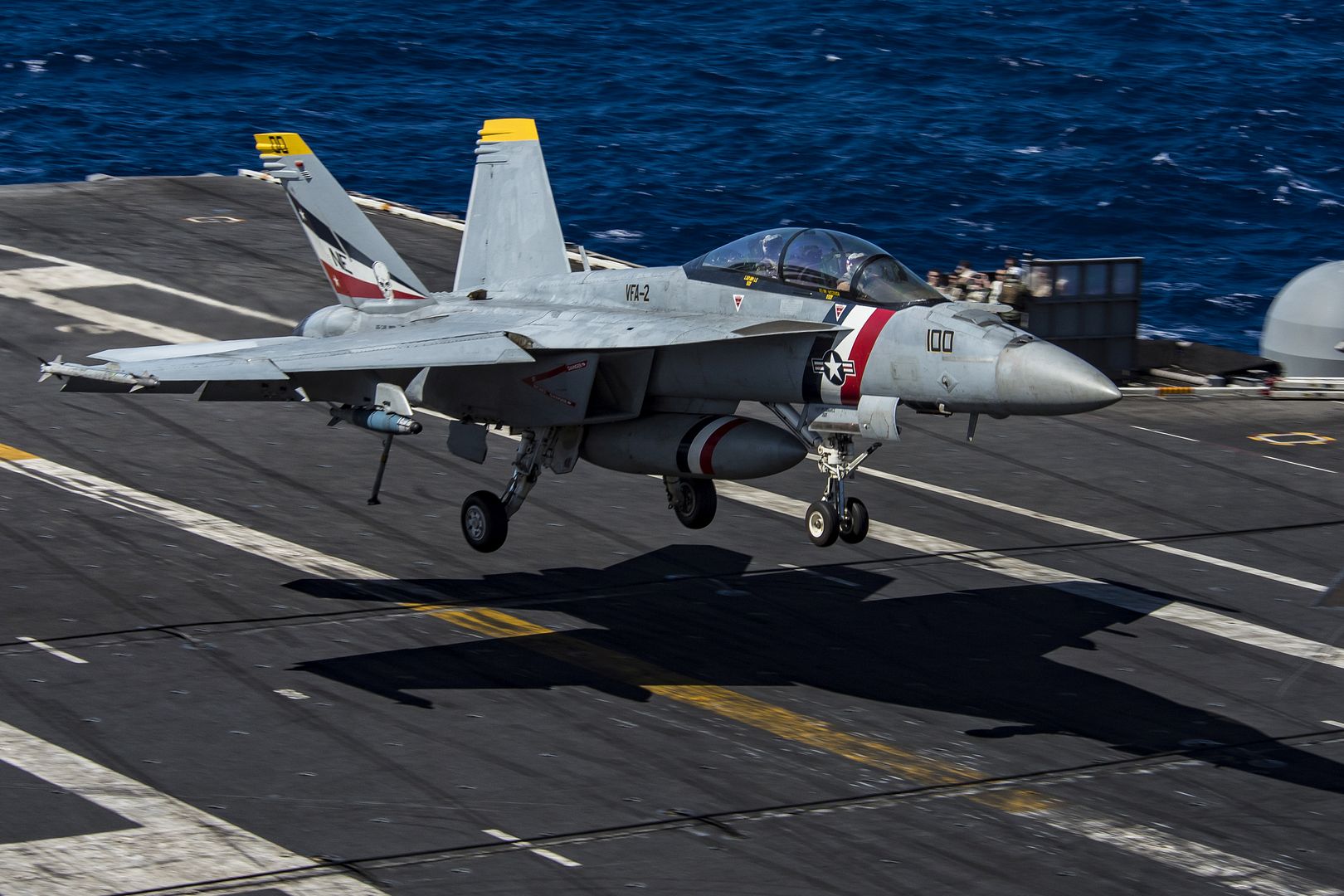
PACIFIC OCEAN (Jan. 18, 2018) Capt. Tom Barber, commander, Carrier Air Wing 2, and Cmdr. Jason Hutcherson, commanding officer of the "Bounty Hunters" of Strike Fighter Squadron (VFA) 2, complete their 1,000th carrier arrested landing or "trap" aboard the Nimitz-class aircraft carrier USS Carl Vinson (CVN 70). The Carl Vinson Strike Group is currently operating in the Pacific as part of a regularly scheduled deployment. (U.S. Navy Photo by Mass Communication Specialist 3rd Class Jake Cannady/Released)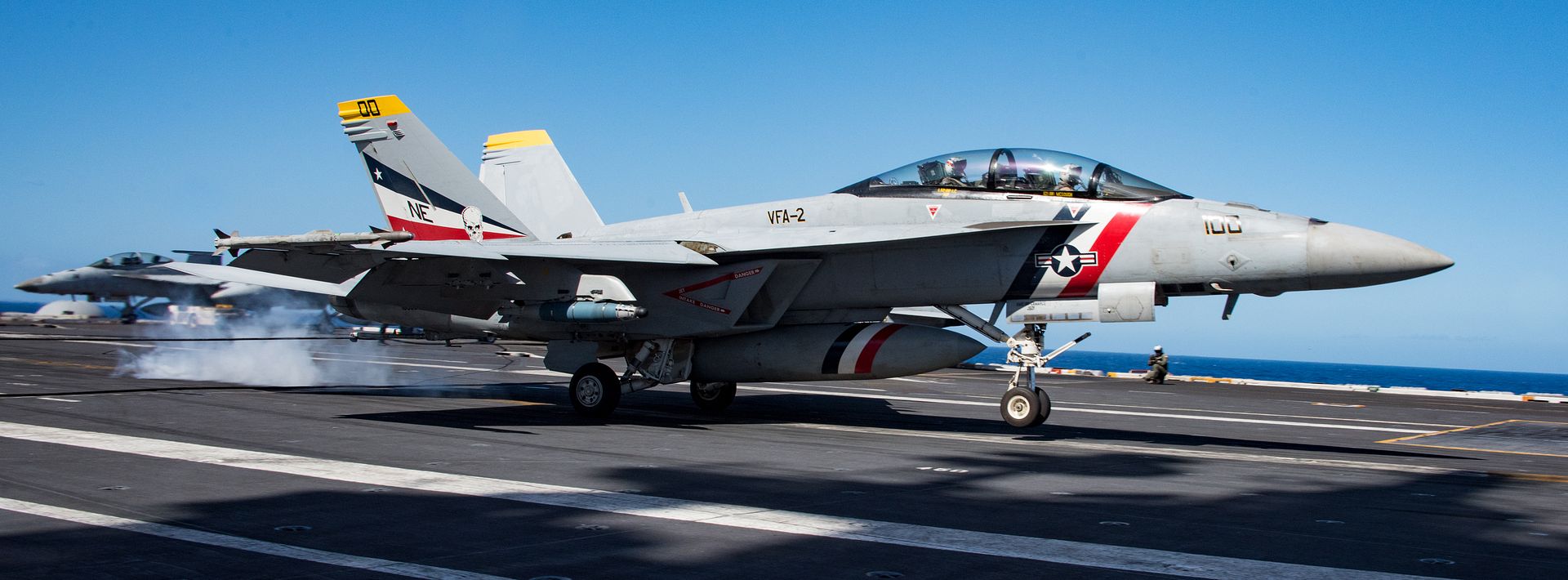
A brand-new video takes viewers into the cockpit of the Eurofighter Typhoon combat aircraft, providing a fly-along perspective with Spanish Air Force pilots operating from Mor?n Air Base southeast of Seville, Spain.
With 360-degree high-resolution cameras mounted inside the cockpit canopies ? using strong suction cups to withstand the g-forces experienced during flight ? the video provides a pilot?s eye view from the powerful swing-role combat aircraft as it undergoes air to air refueling and engages in a simulated dog fight.
Post a reply
- Go to Previous topic
- Go to Next topic
- Go to Welcome
- Go to Introduce Yourself
- Go to General Discussion
- Go to Screenshots, Images and Videos
- Go to Off topic
- Go to Works in Progress
- Go to Skinning Tips / Tutorials
- Go to Skin Requests
- Go to IJAAF Library
- Go to Luftwaffe Library
- Go to RAF Library
- Go to USAAF / USN Library
- Go to Misc Library
- Go to The Ops Room
- Go to Made in Germany
- Go to Campaigns and Missions
- Go to Works in Progress
- Go to Juri's Air-Raid Shelter
- Go to Campaigns and Missions
- Go to Works in Progress
- Go to Skinpacks
- Go to External Projects Discussion
- Go to Books & Resources
